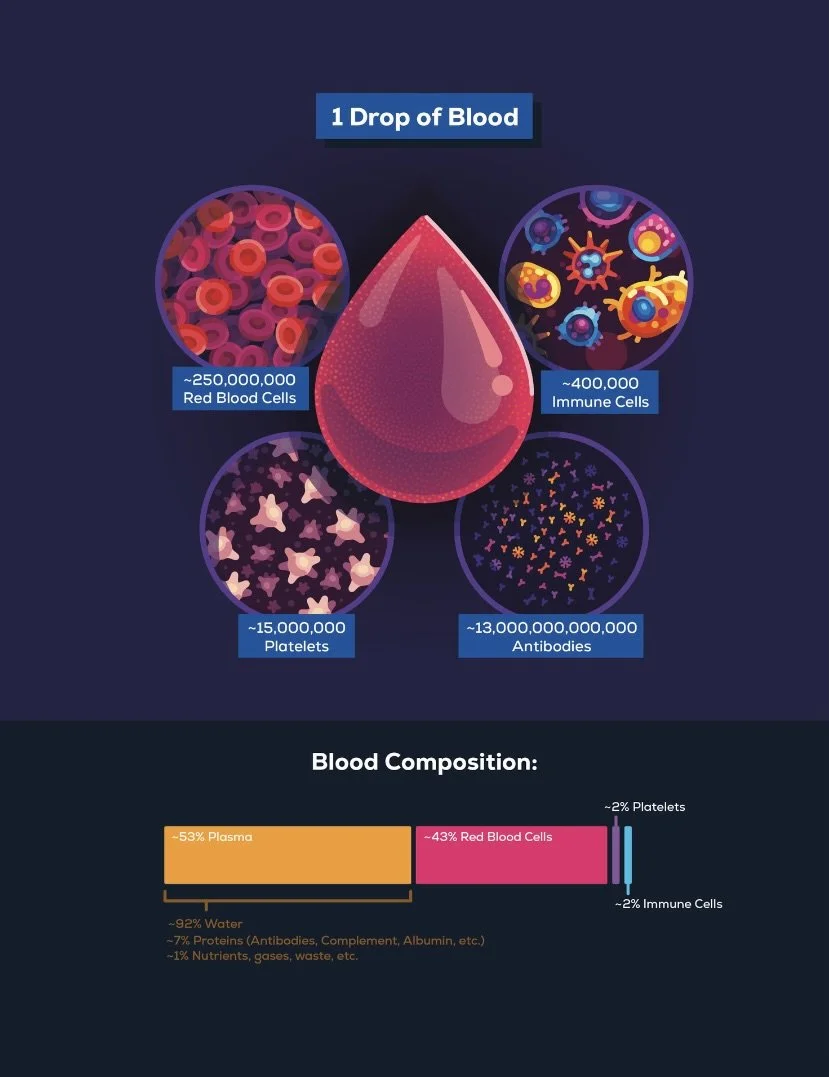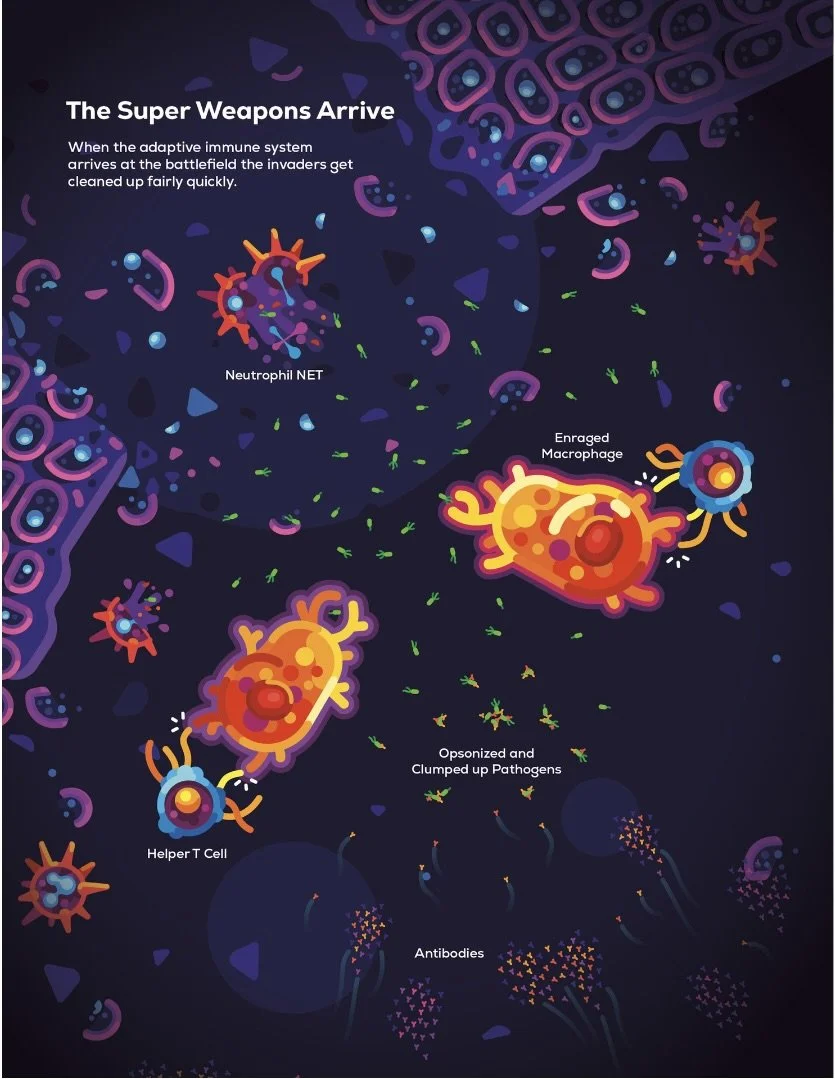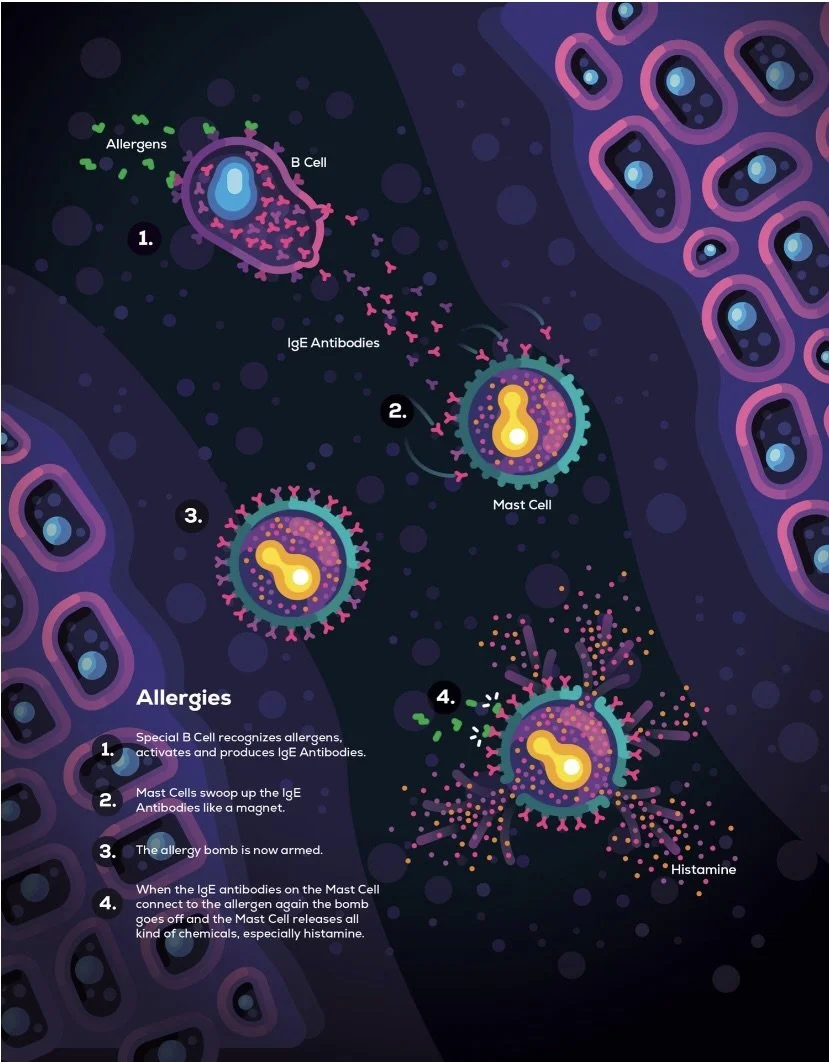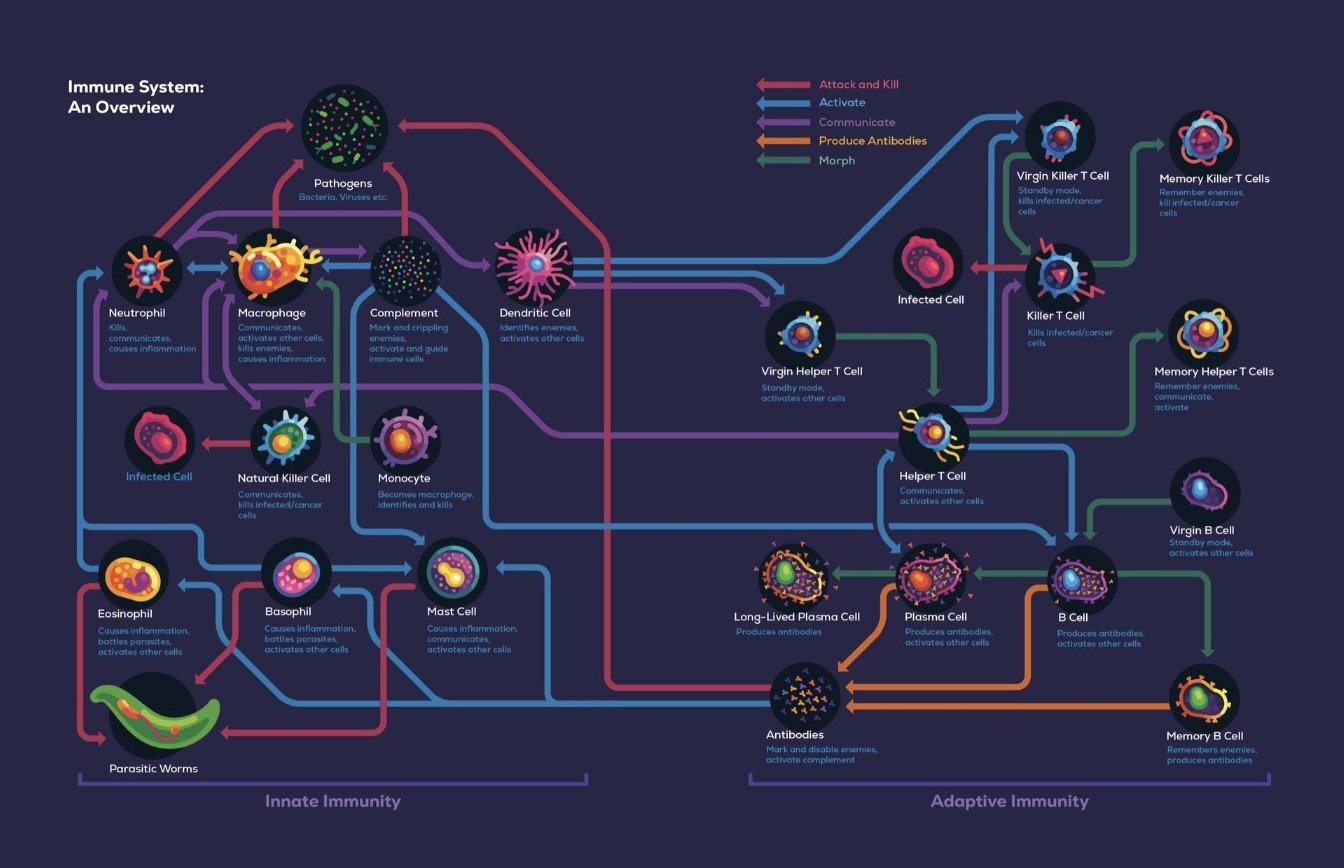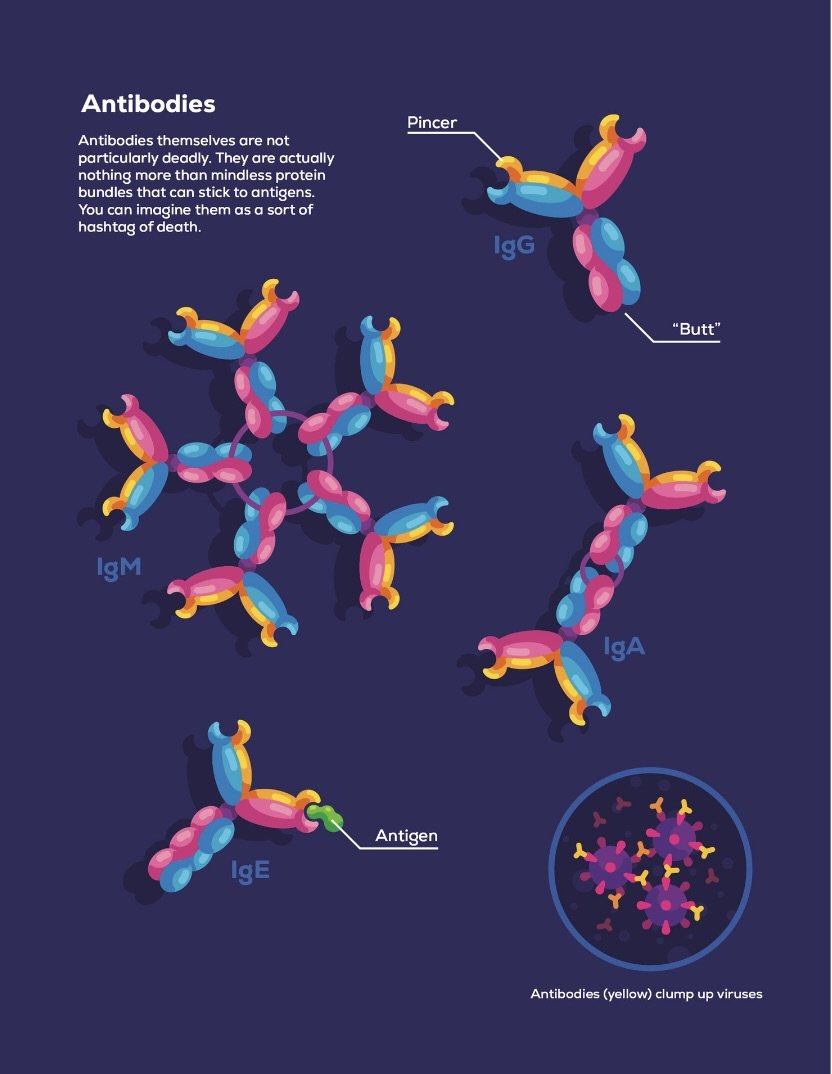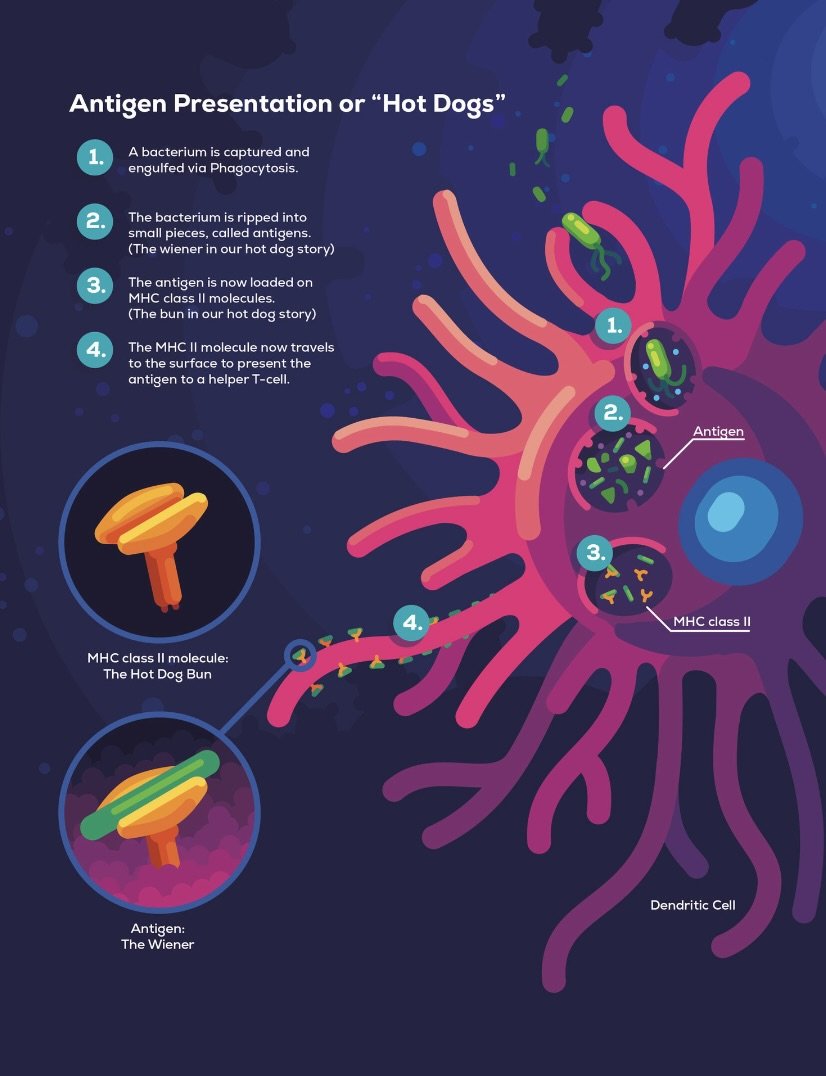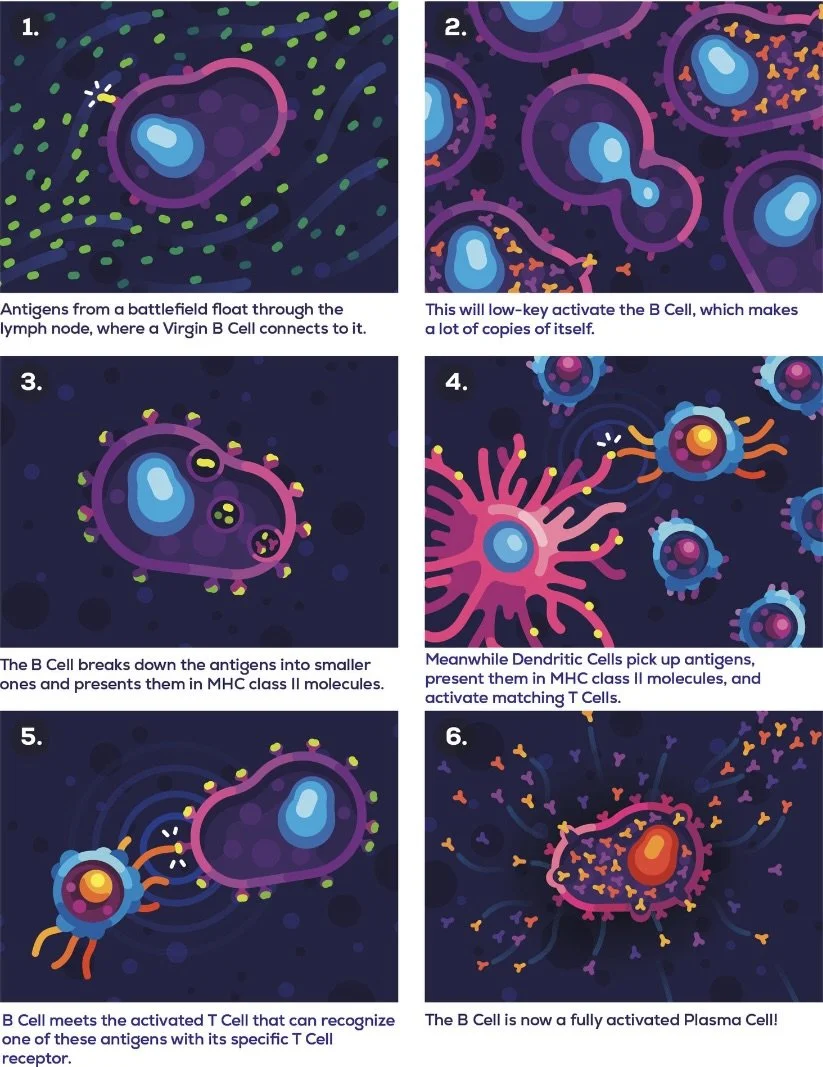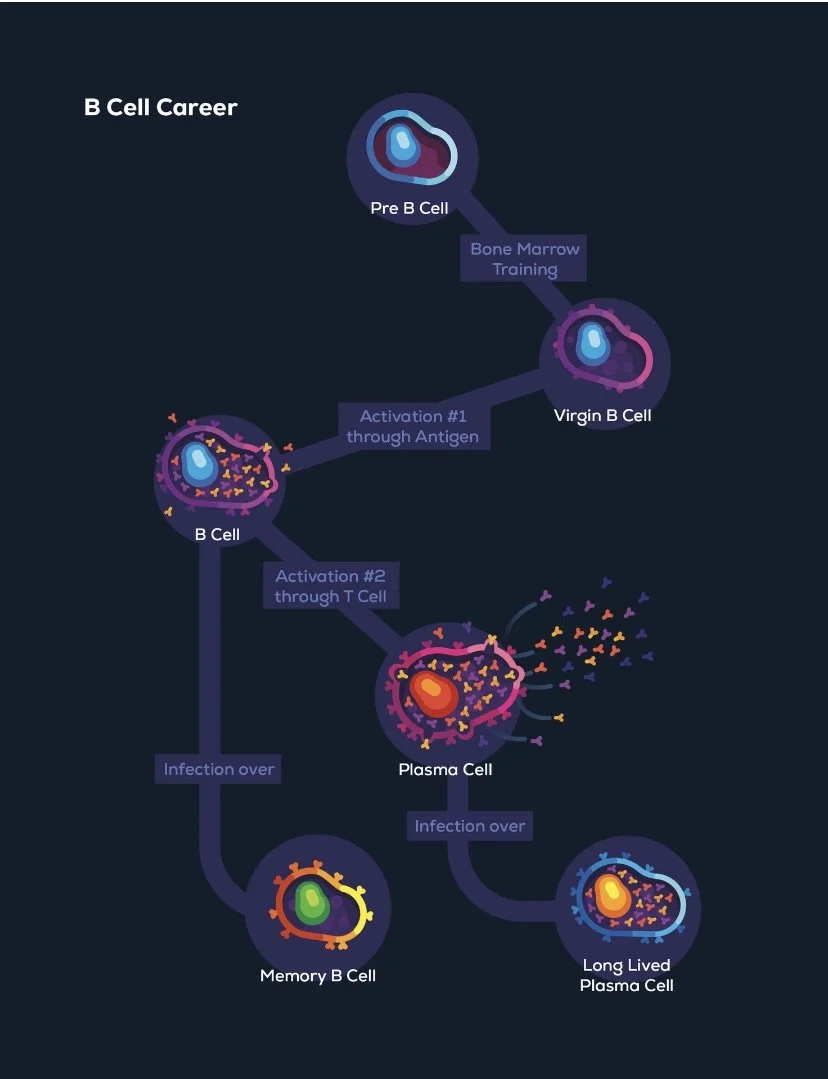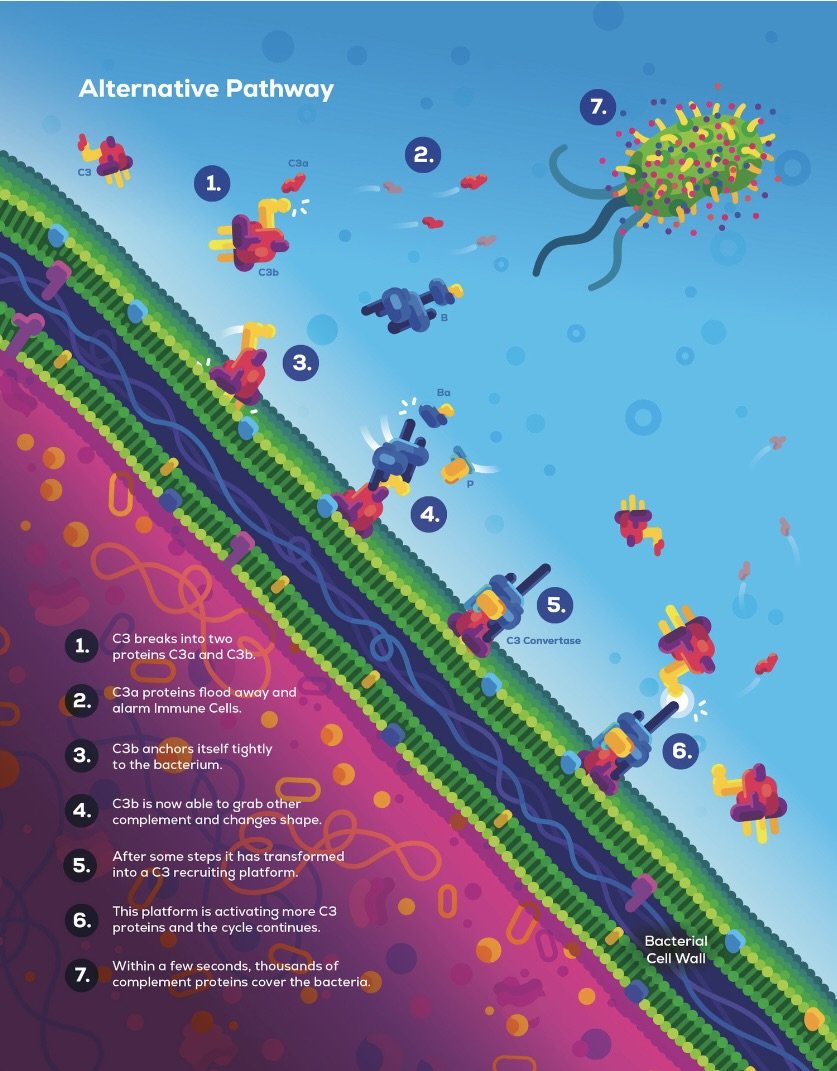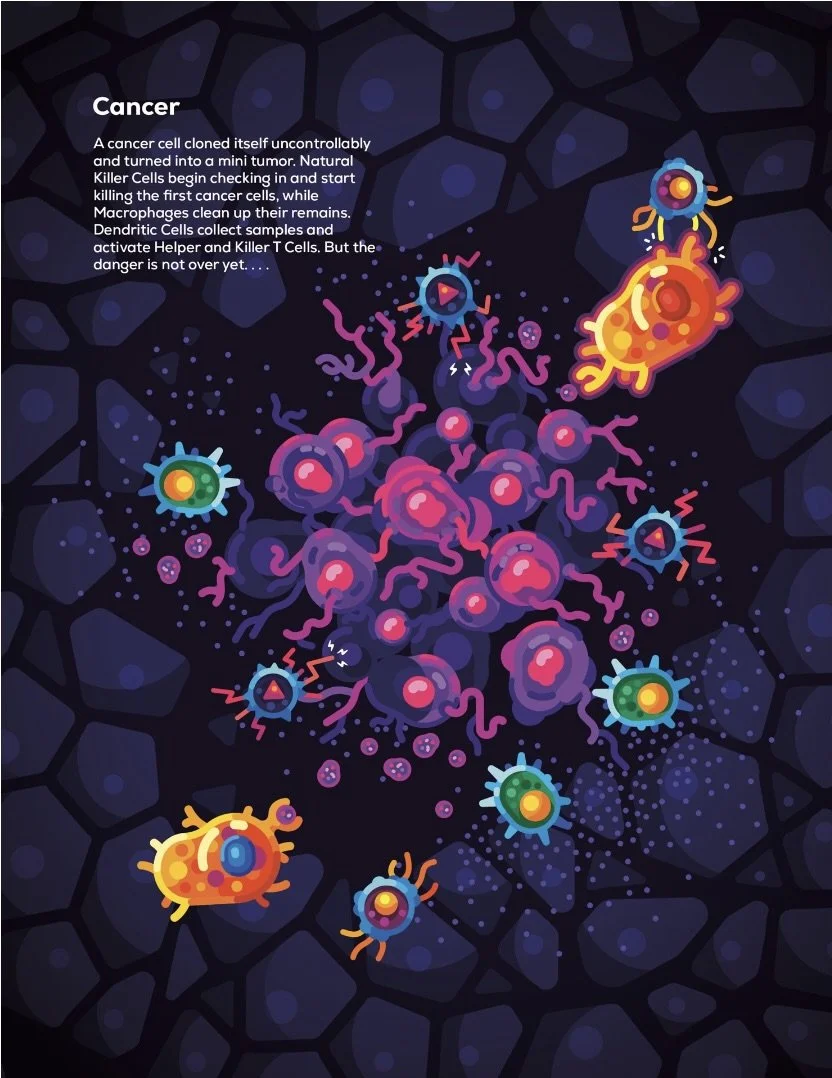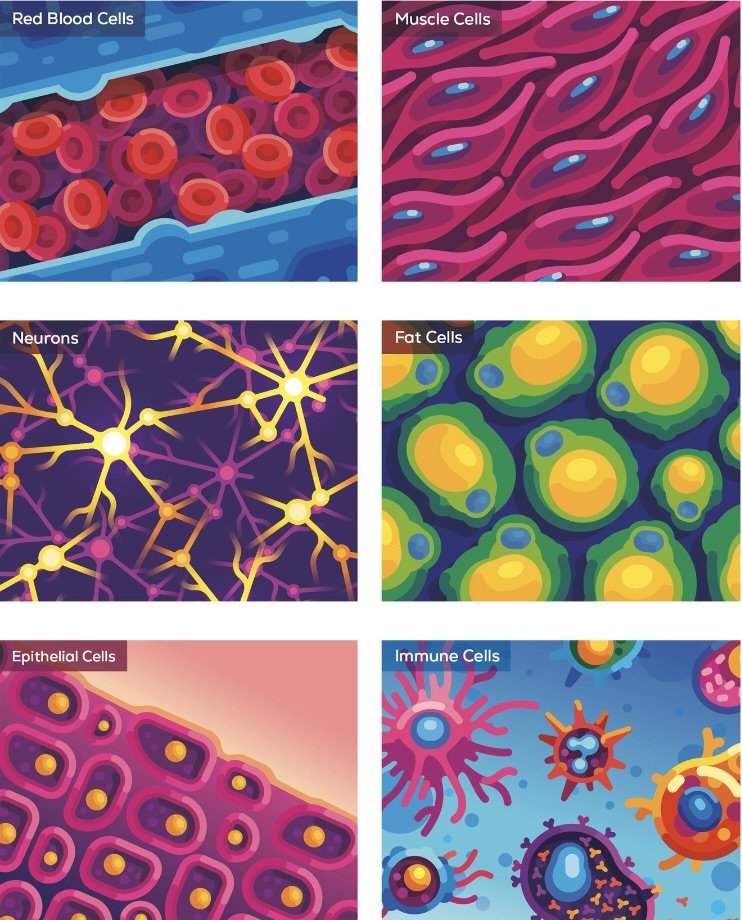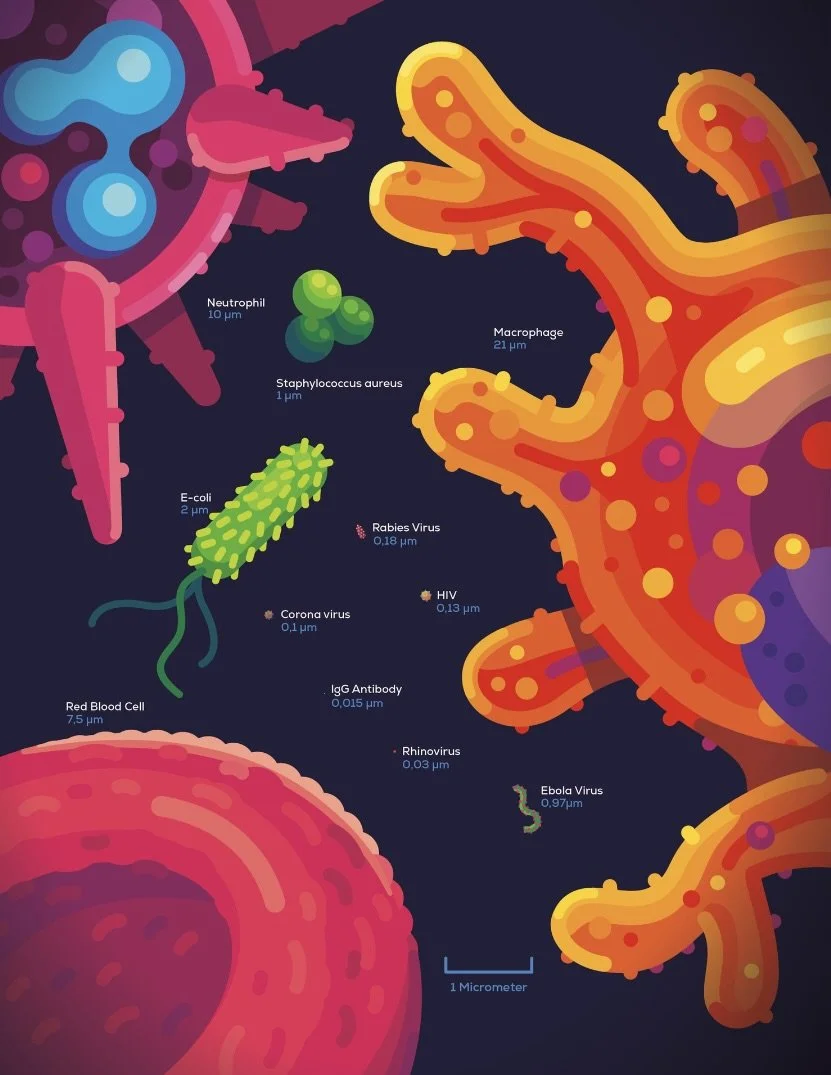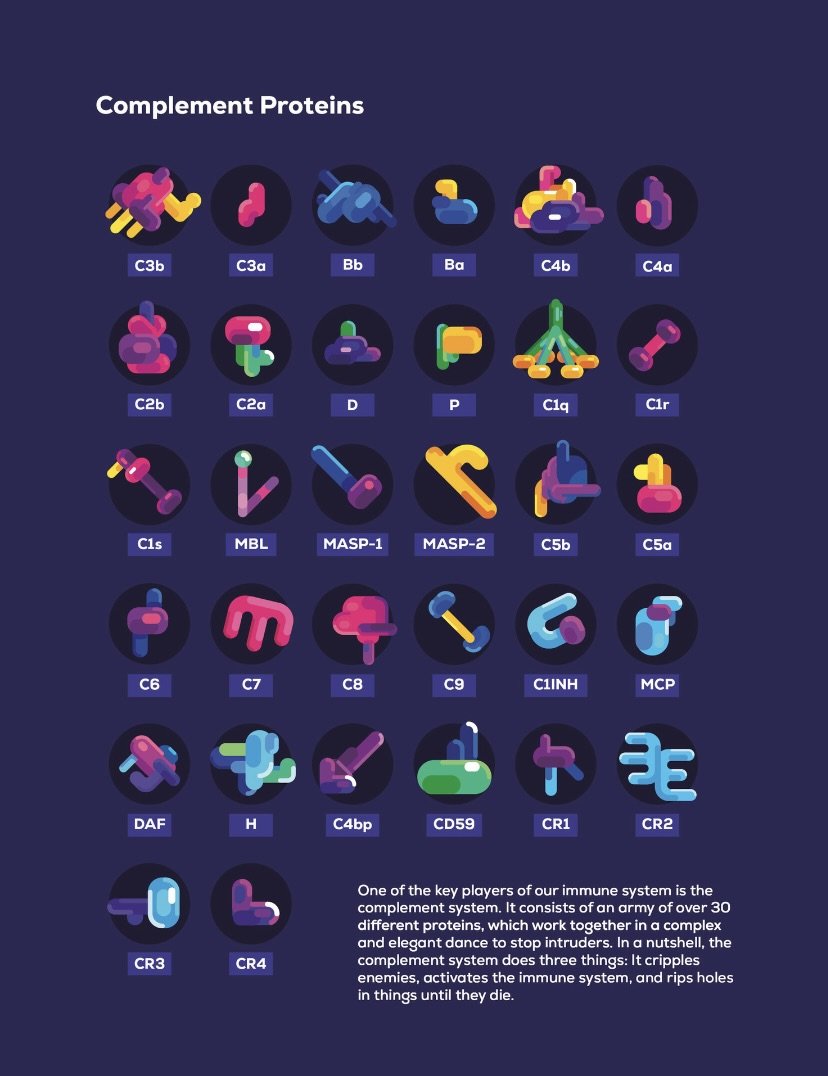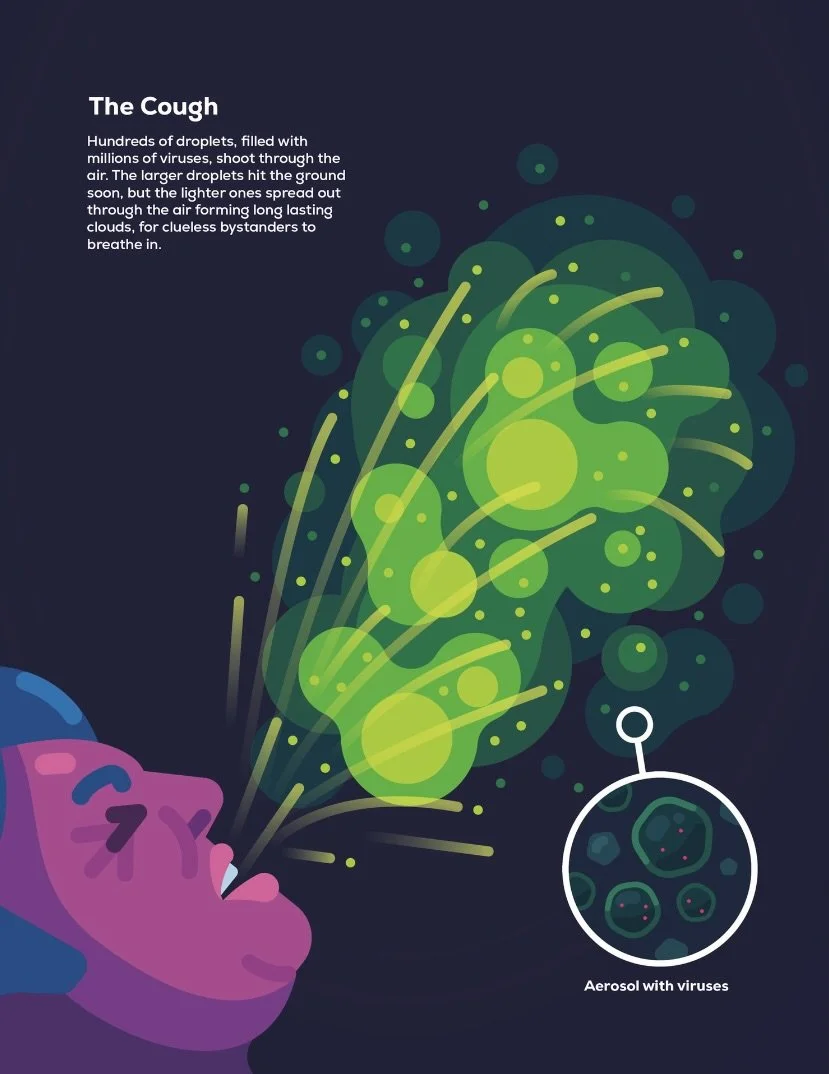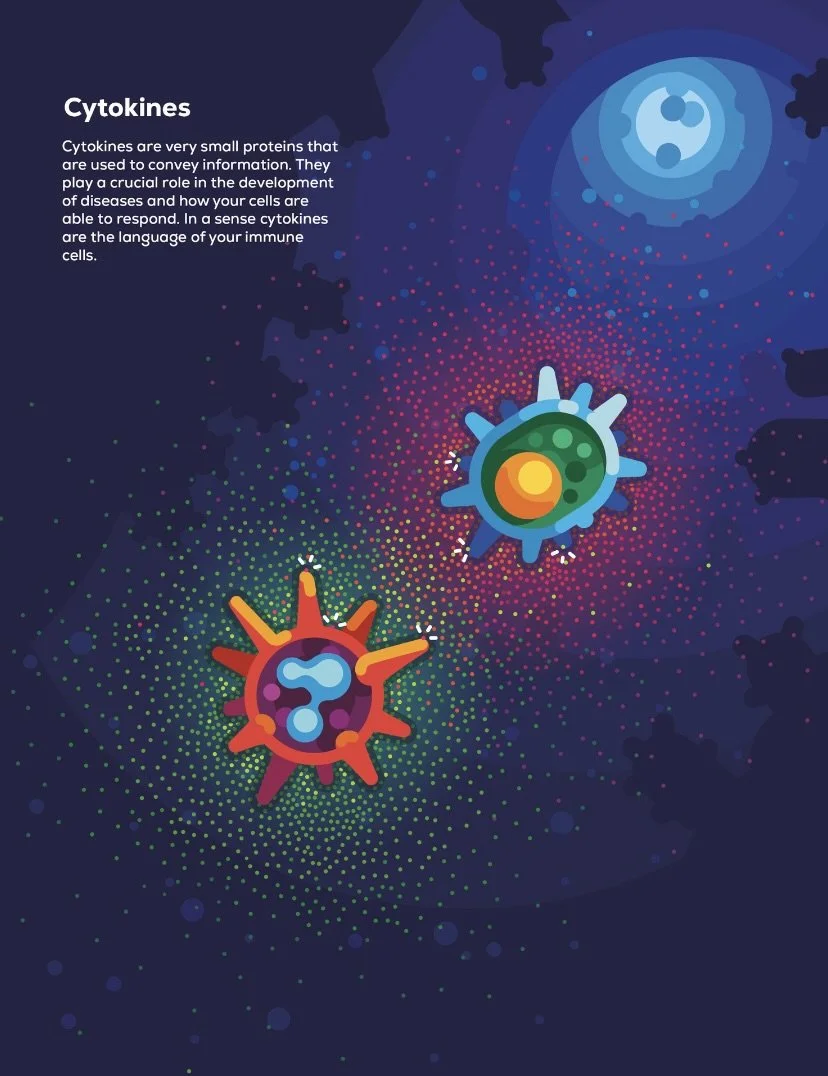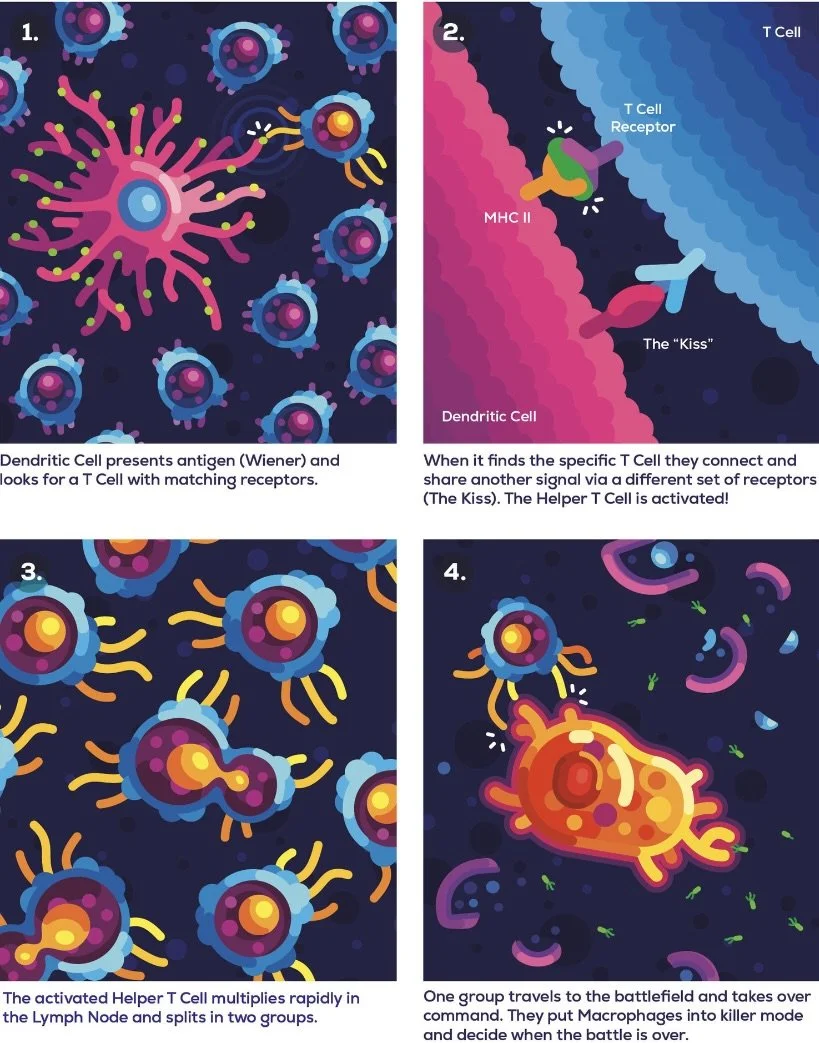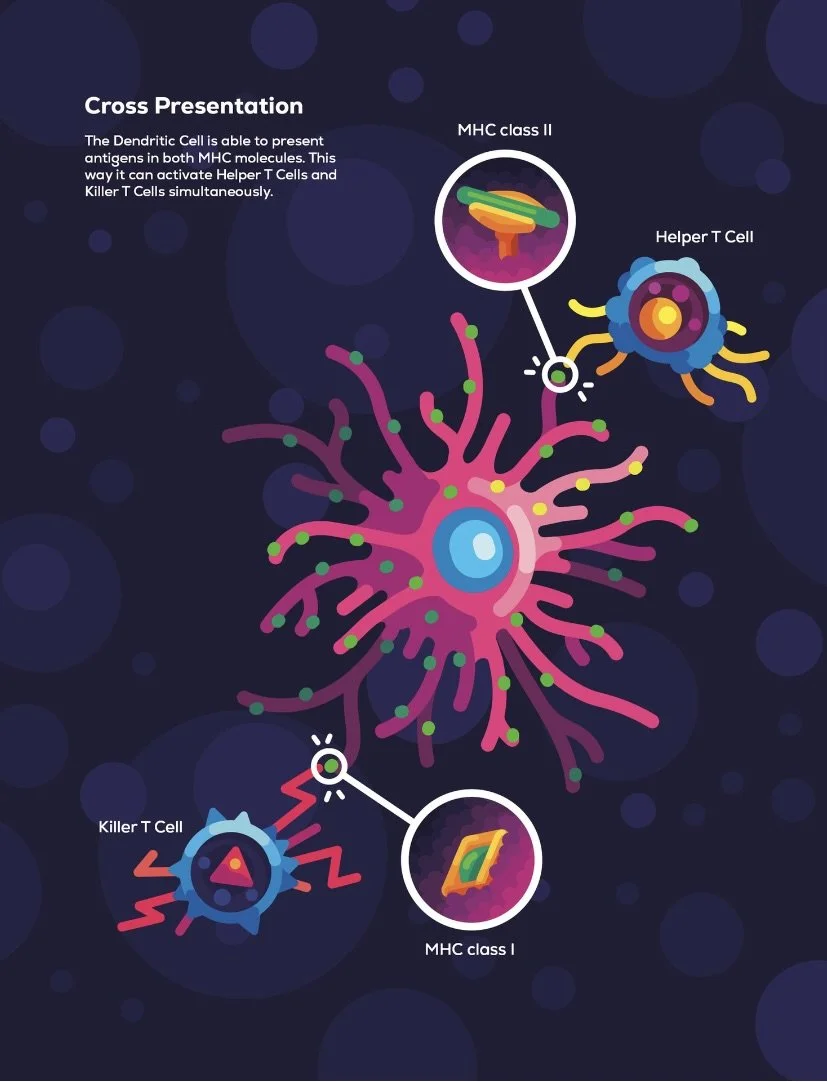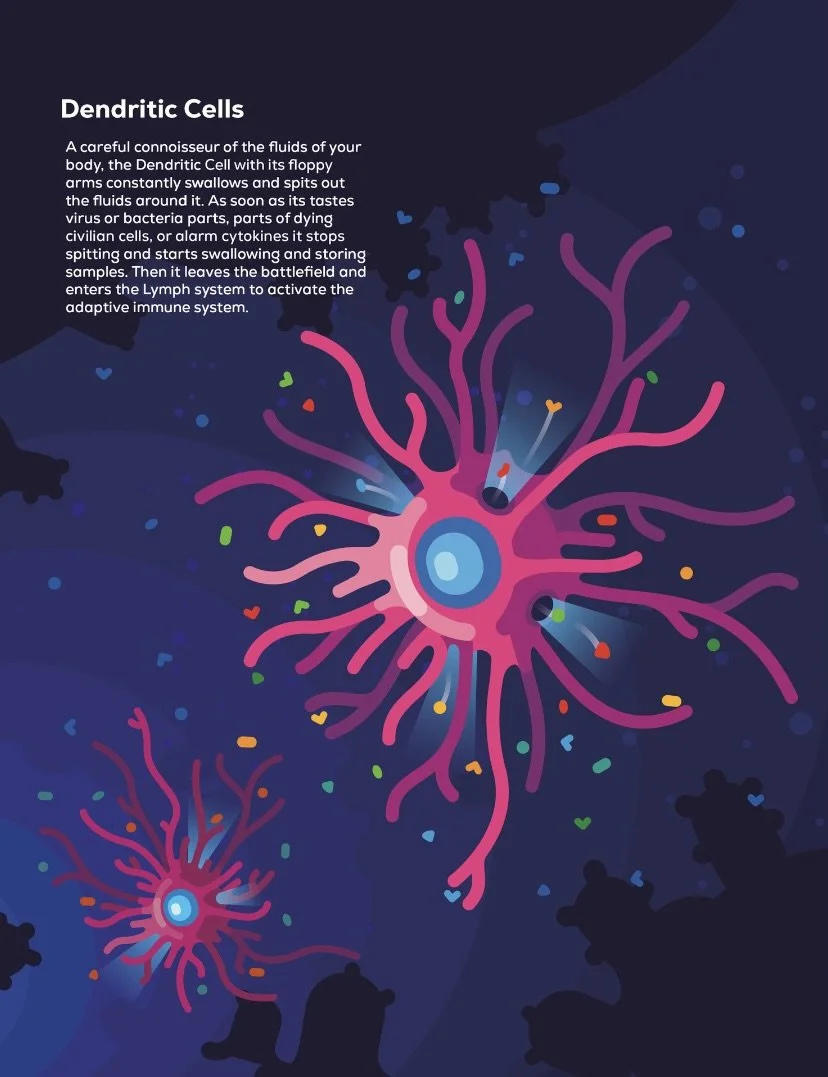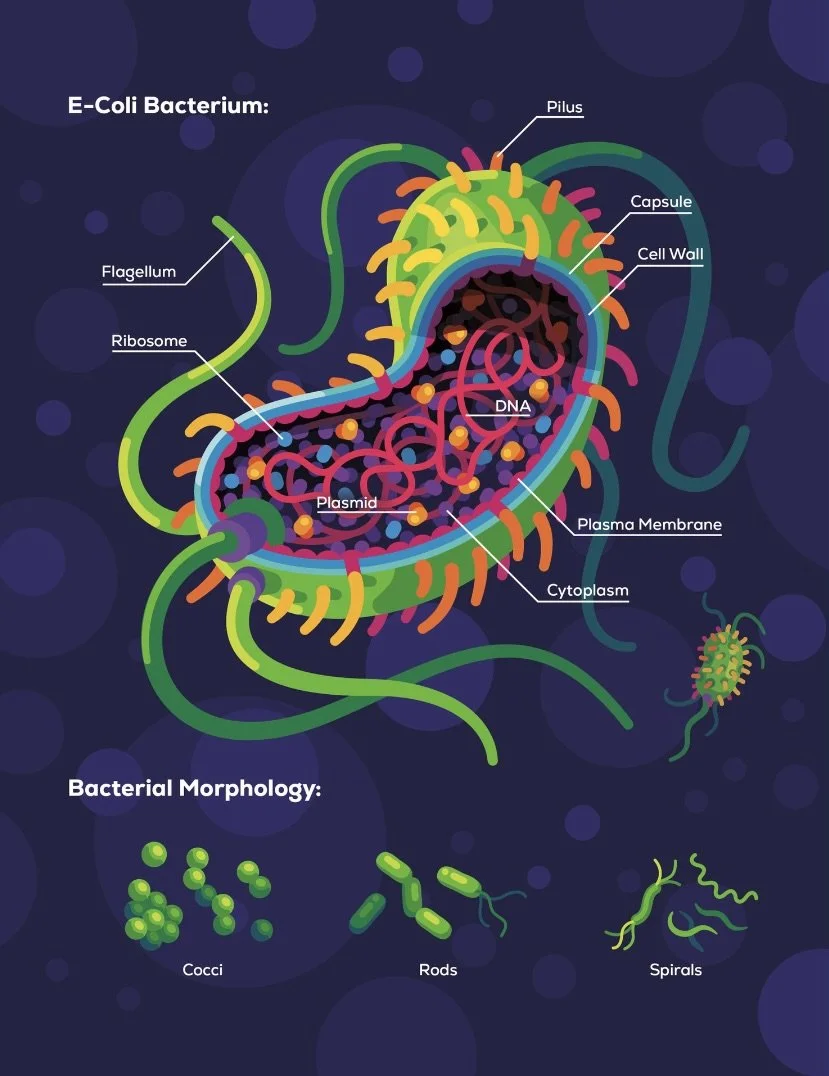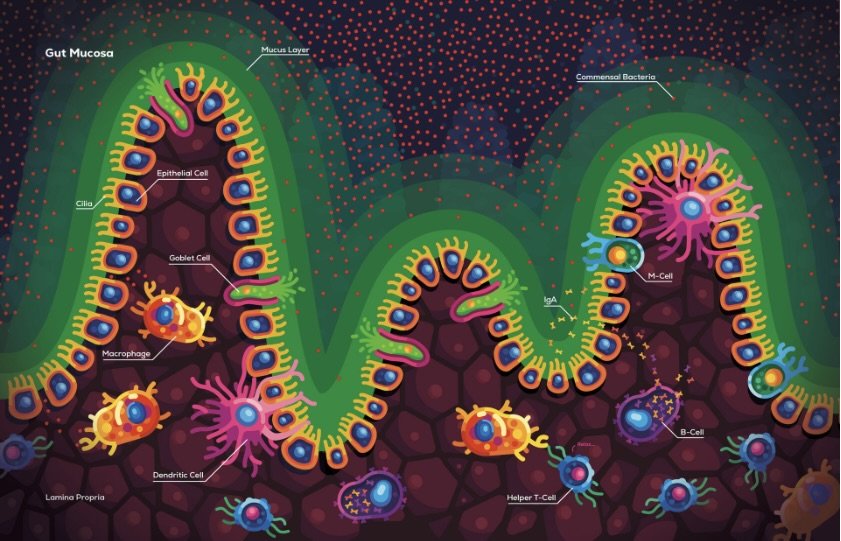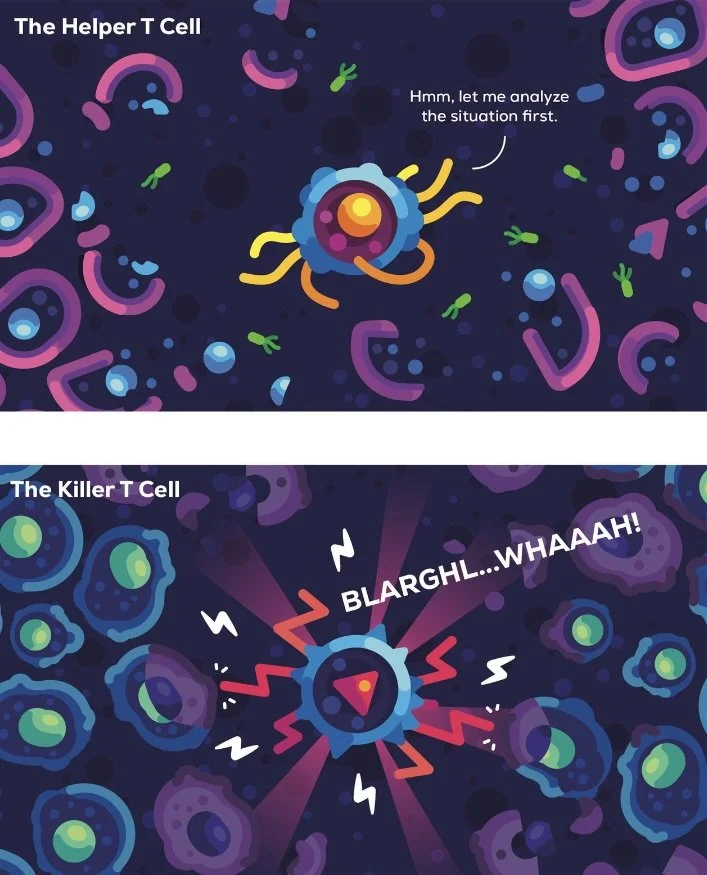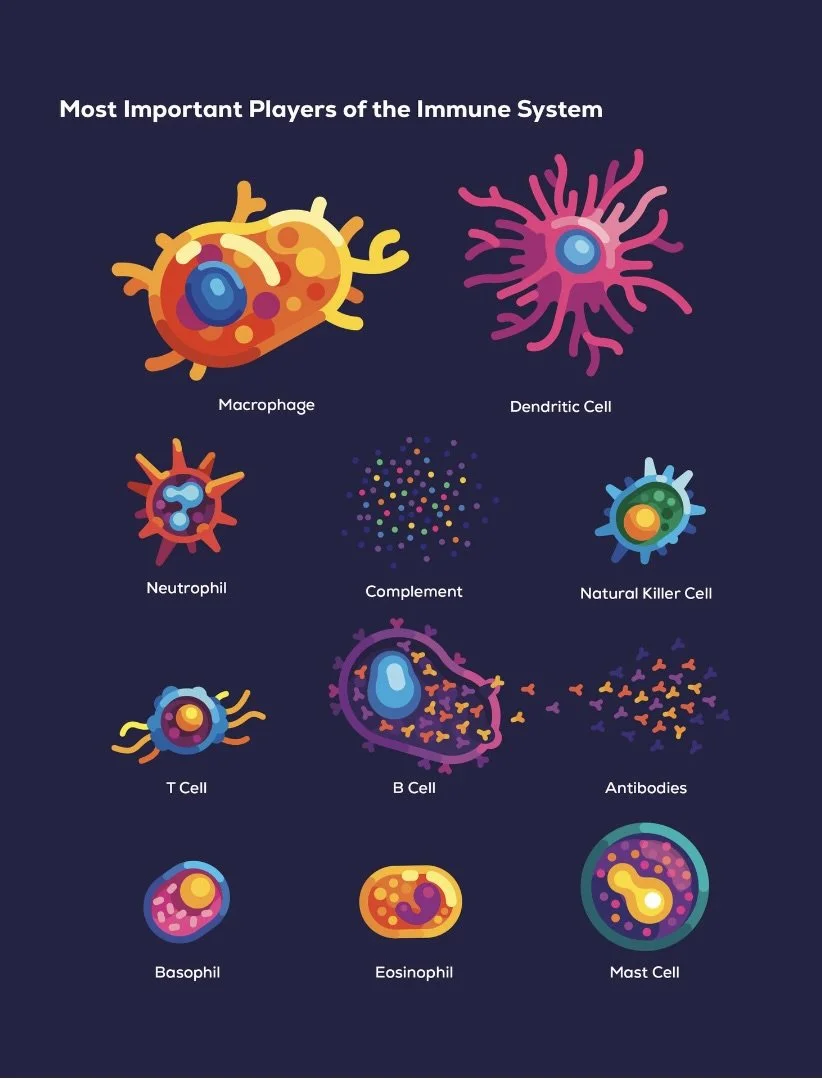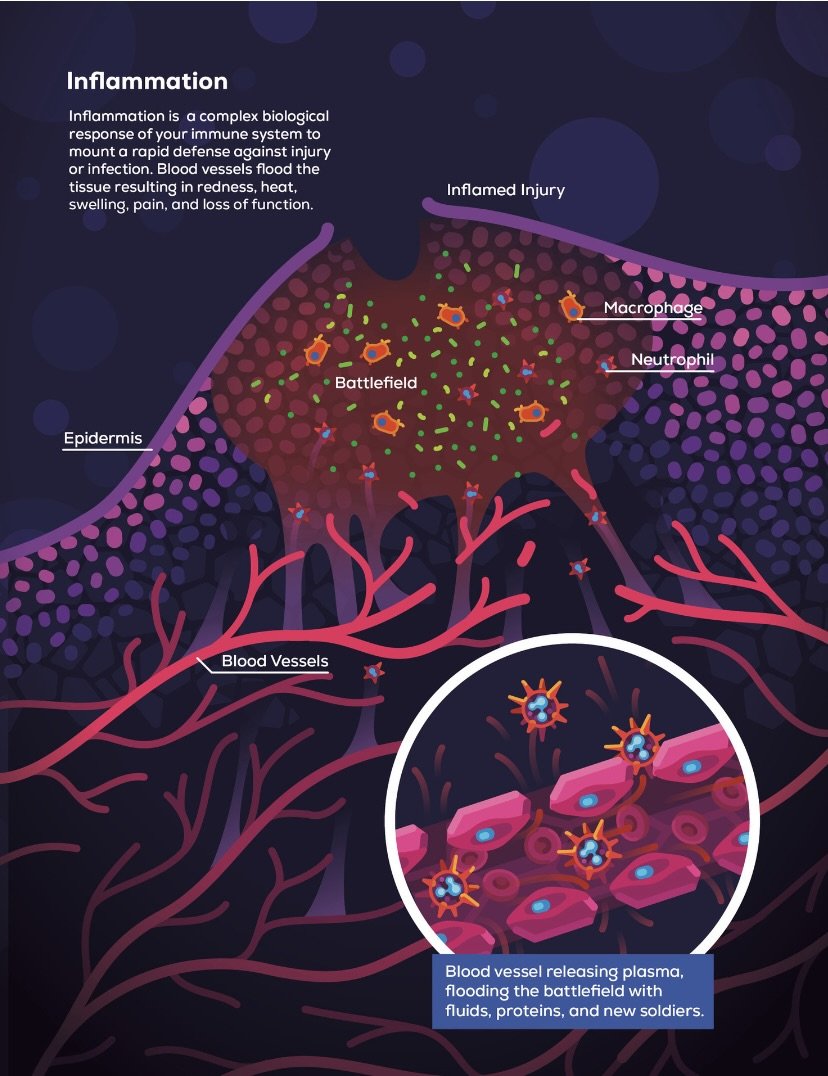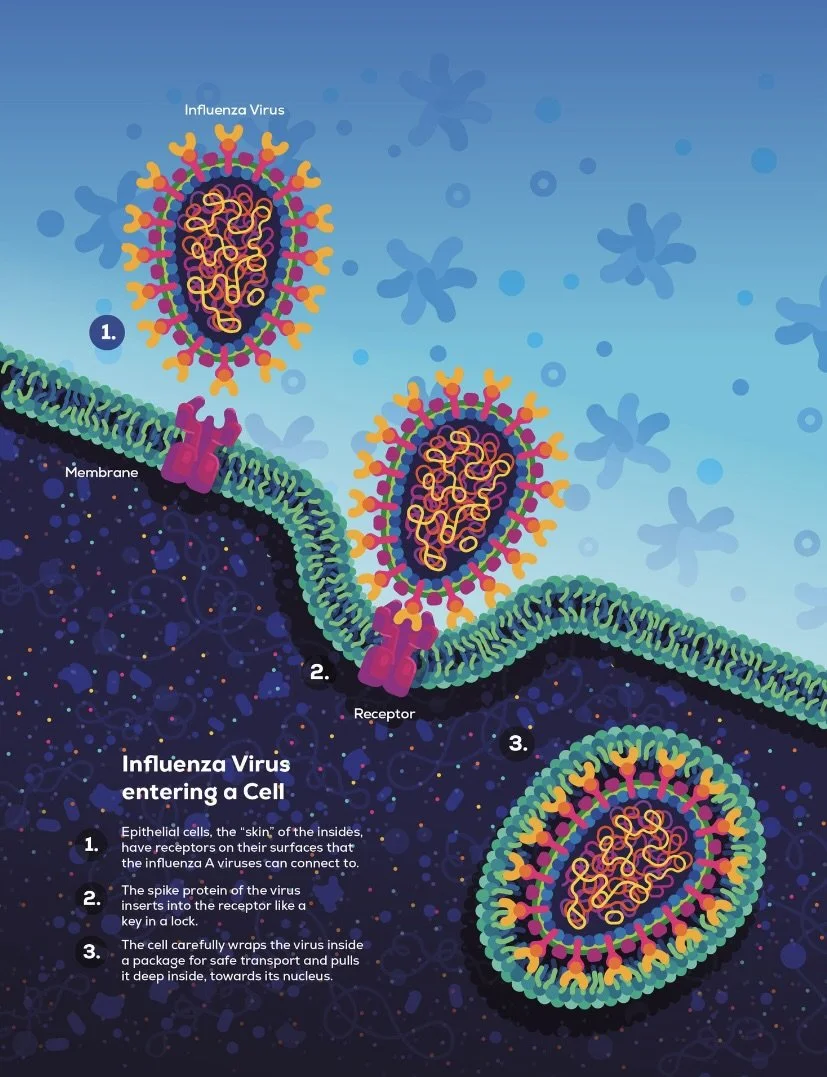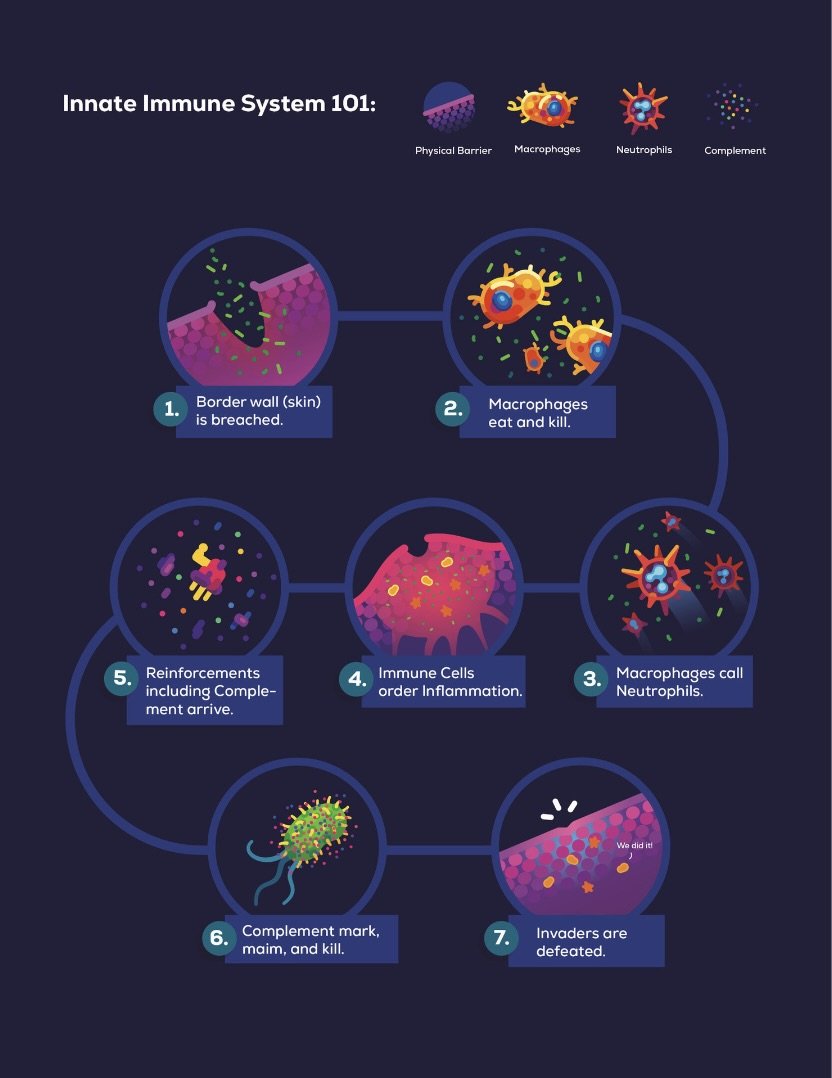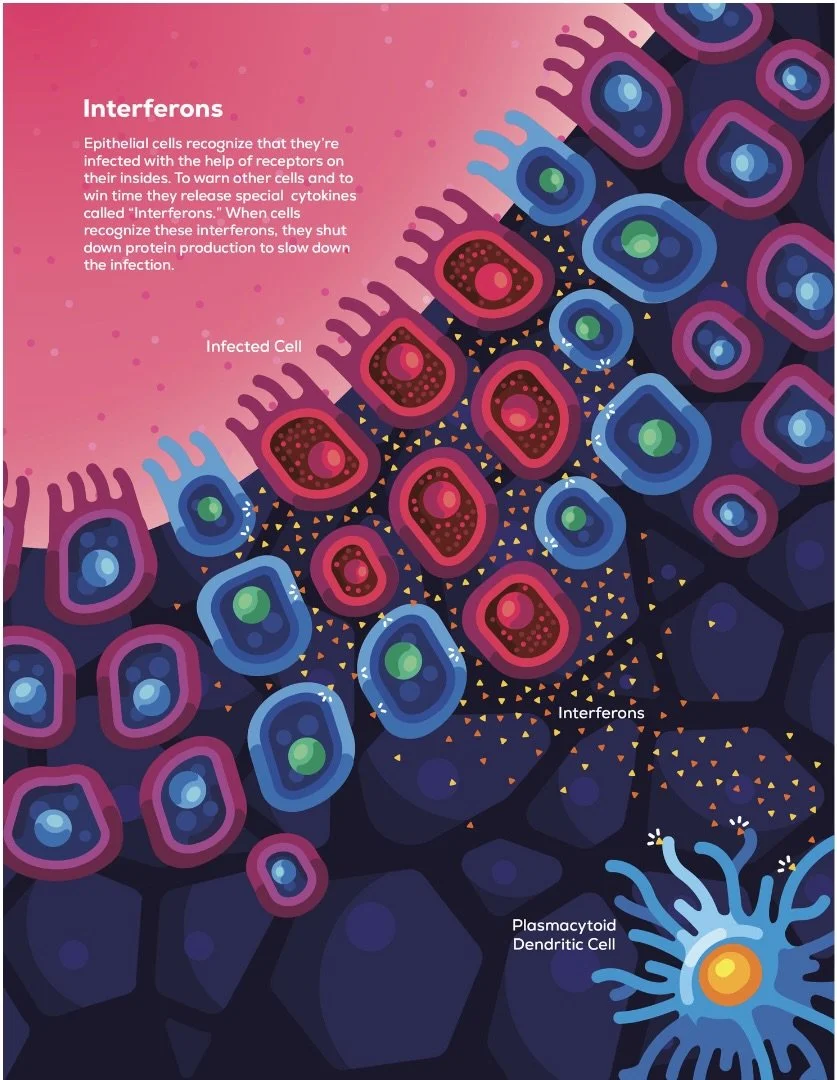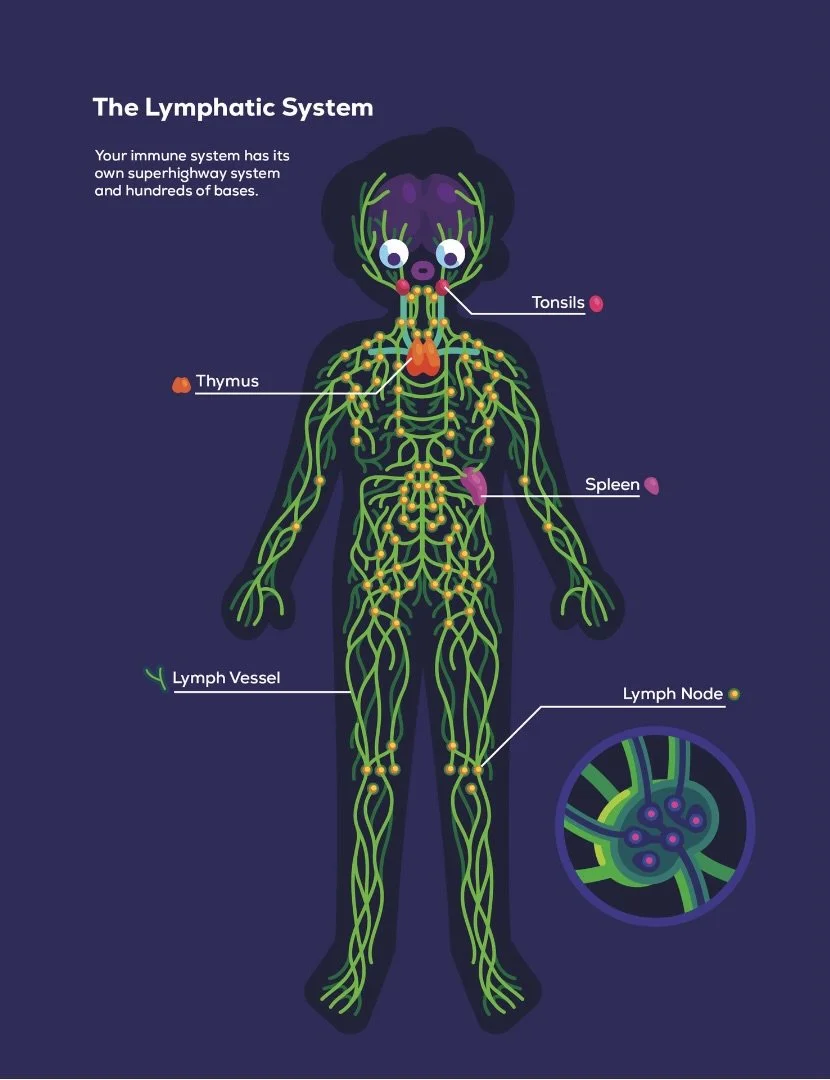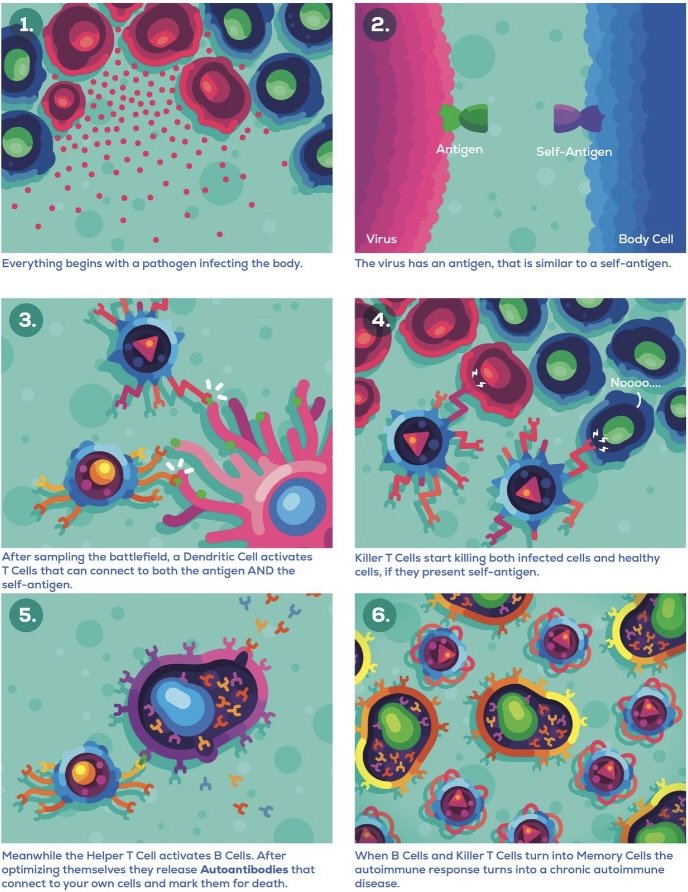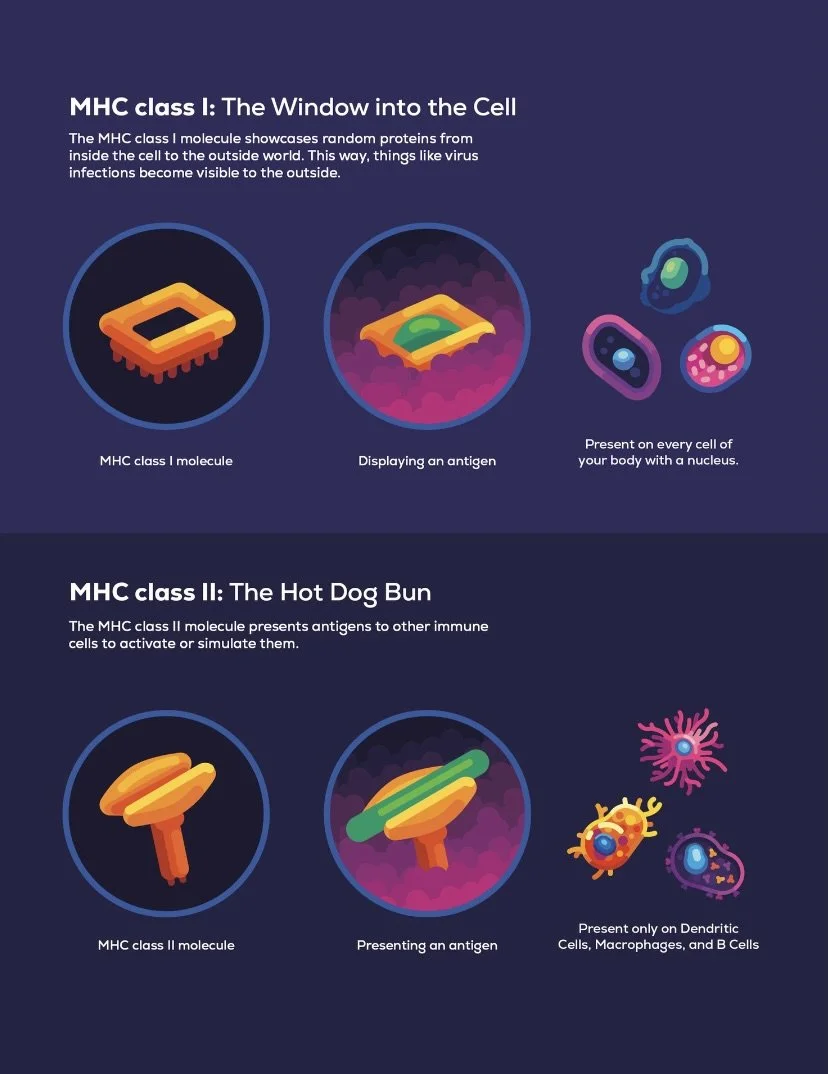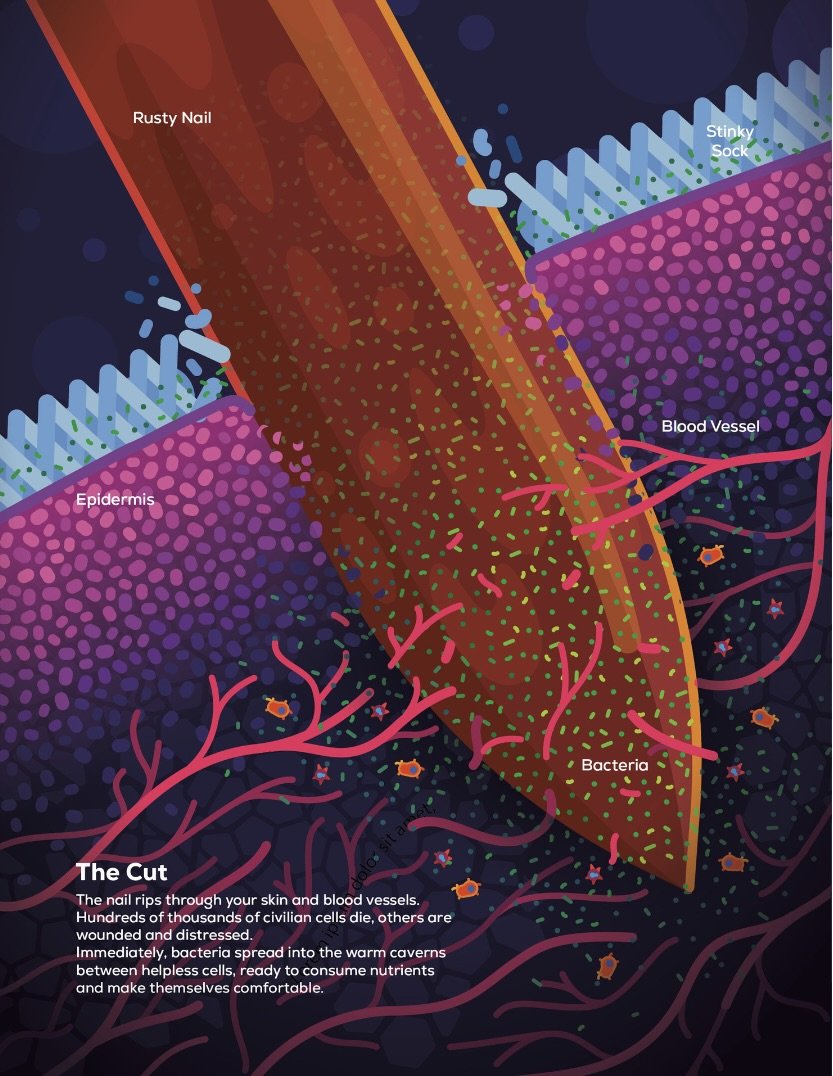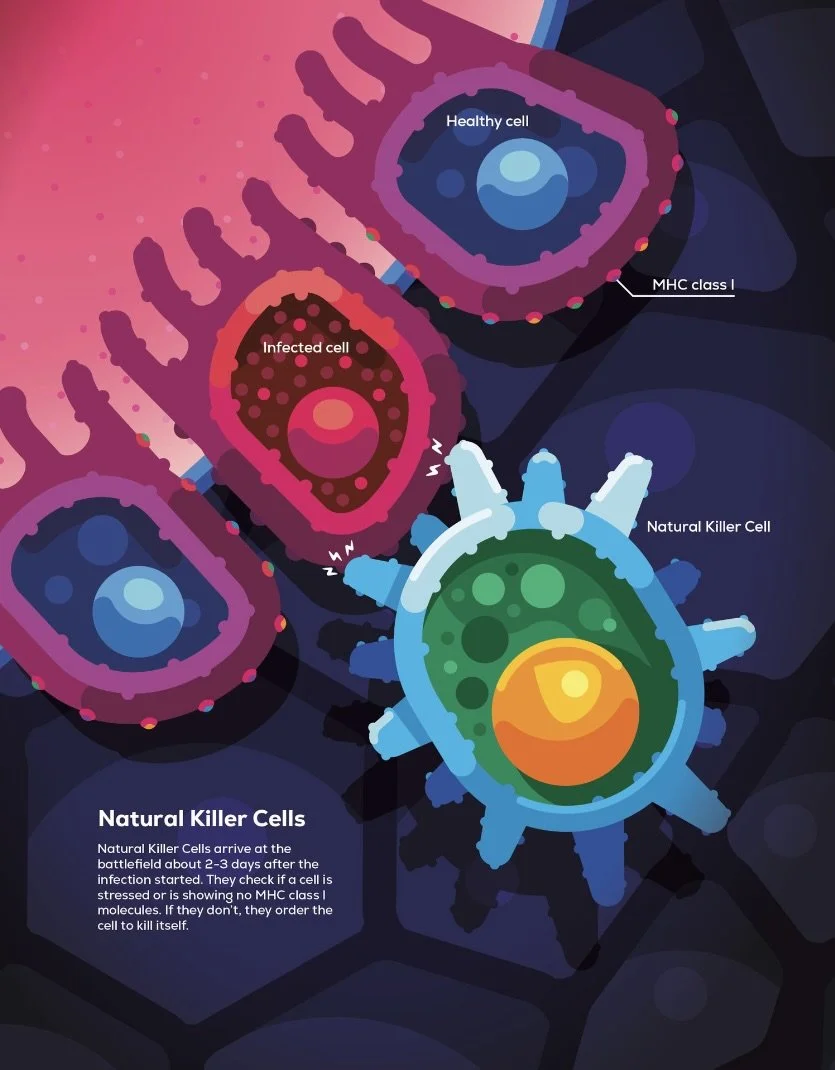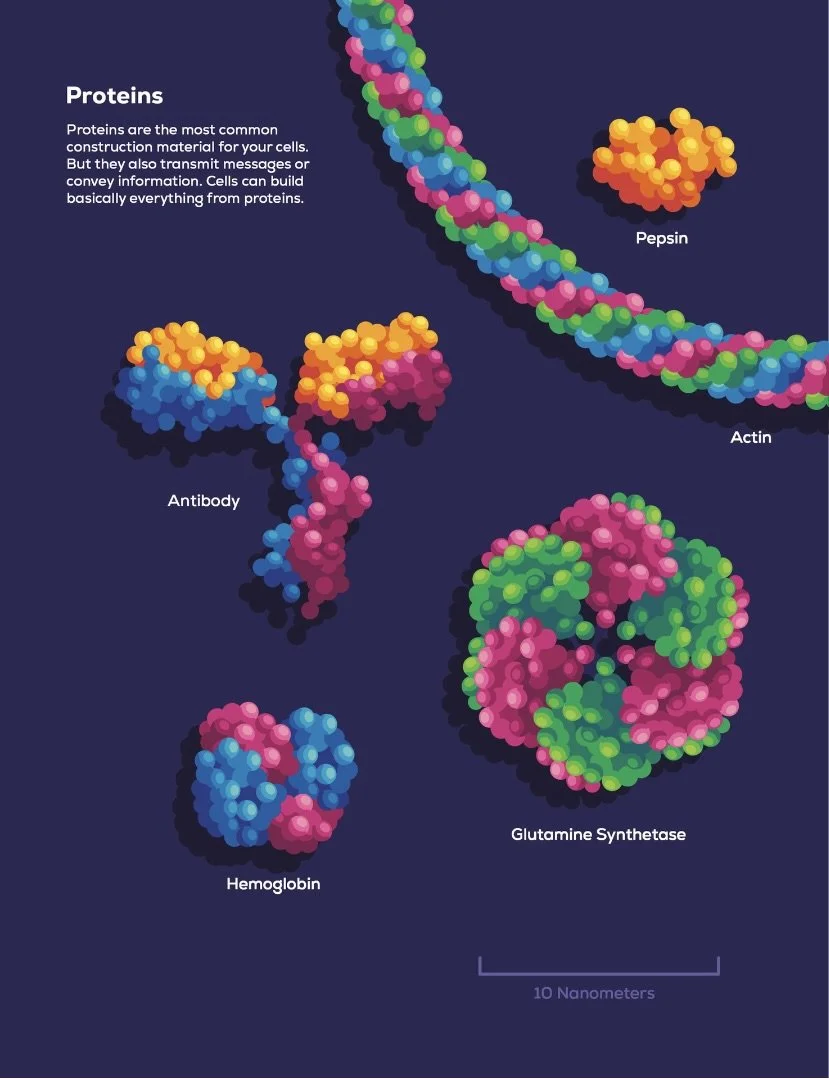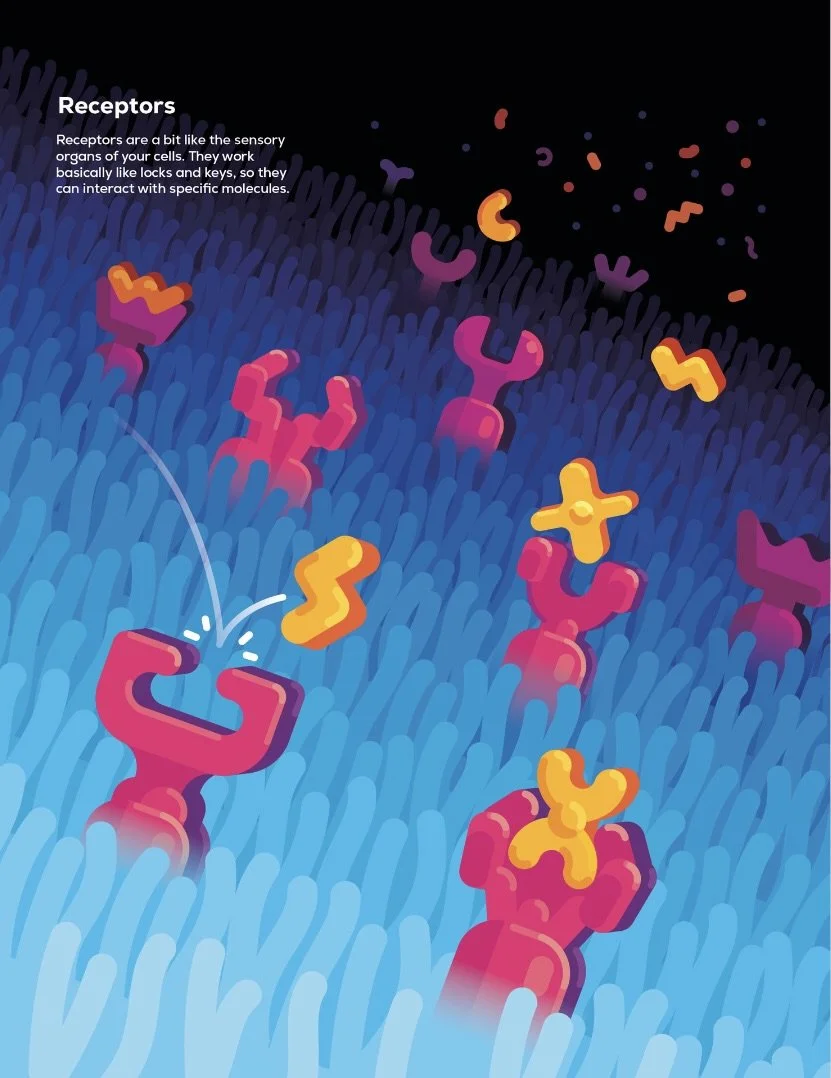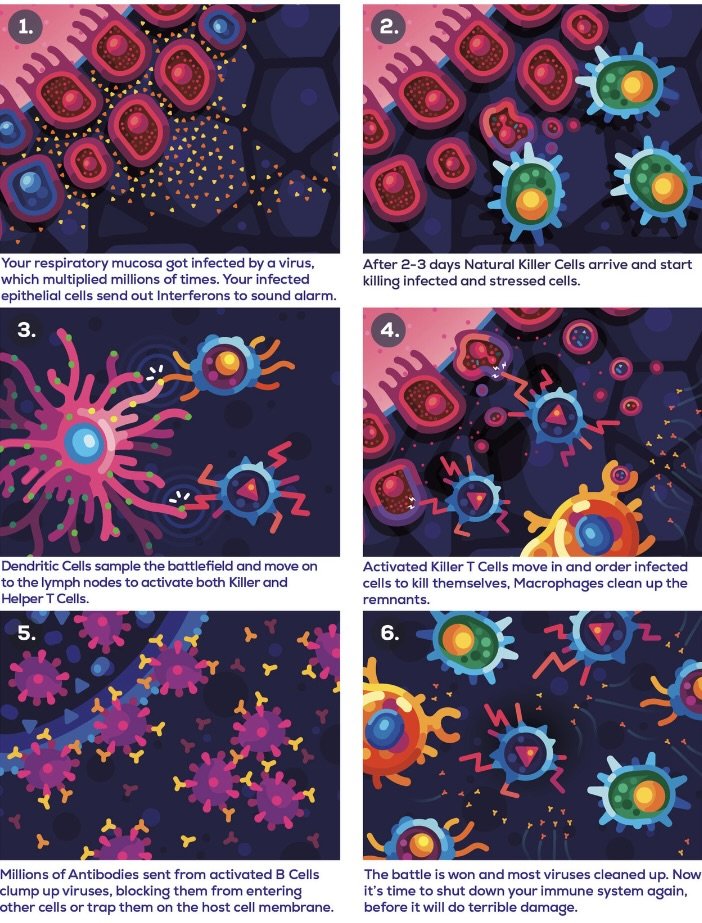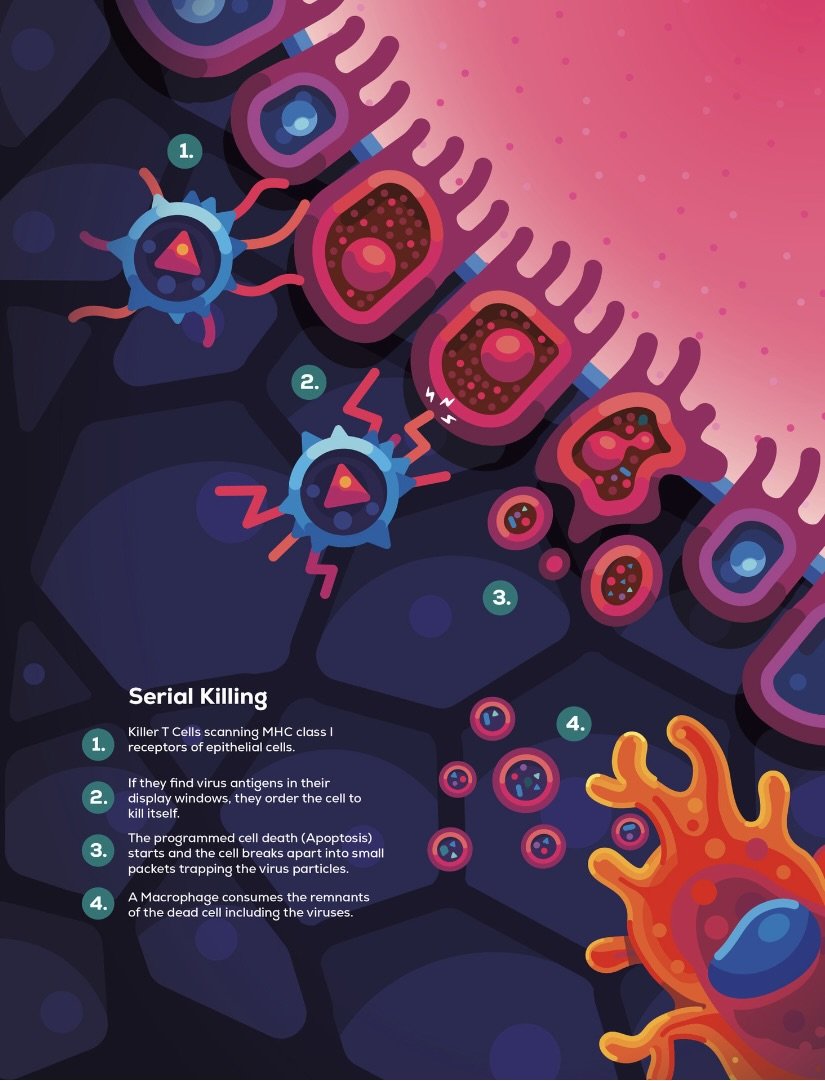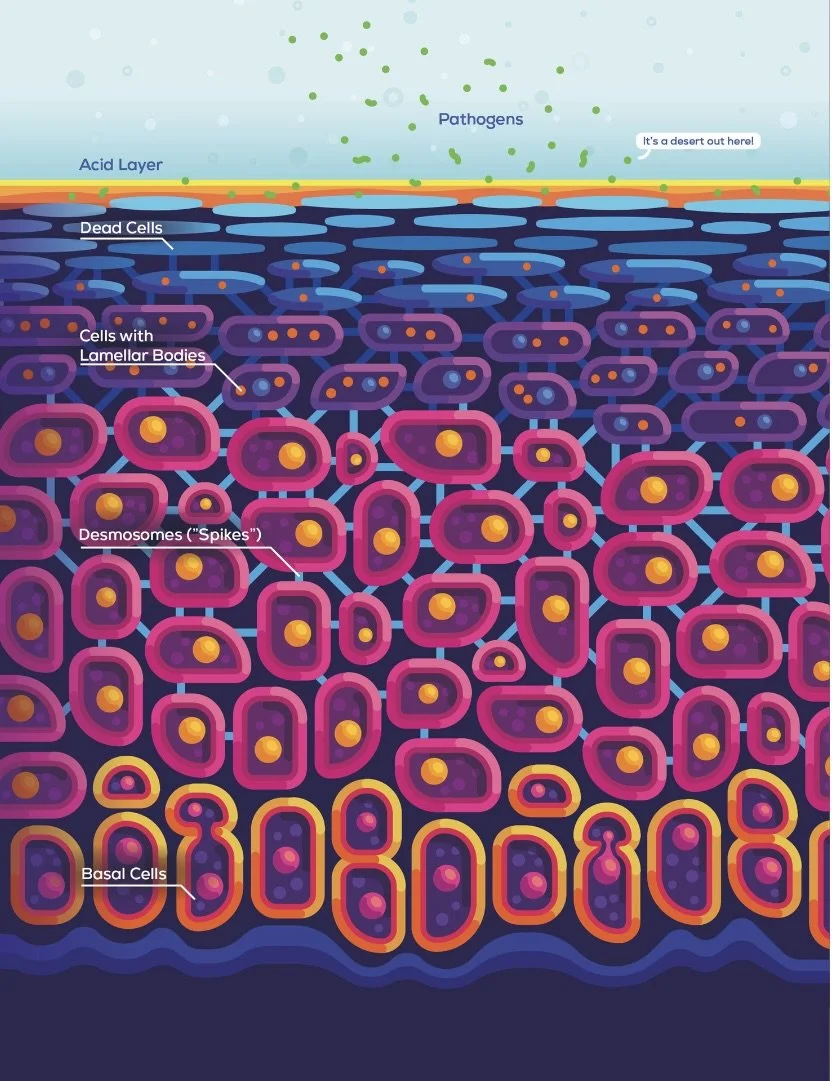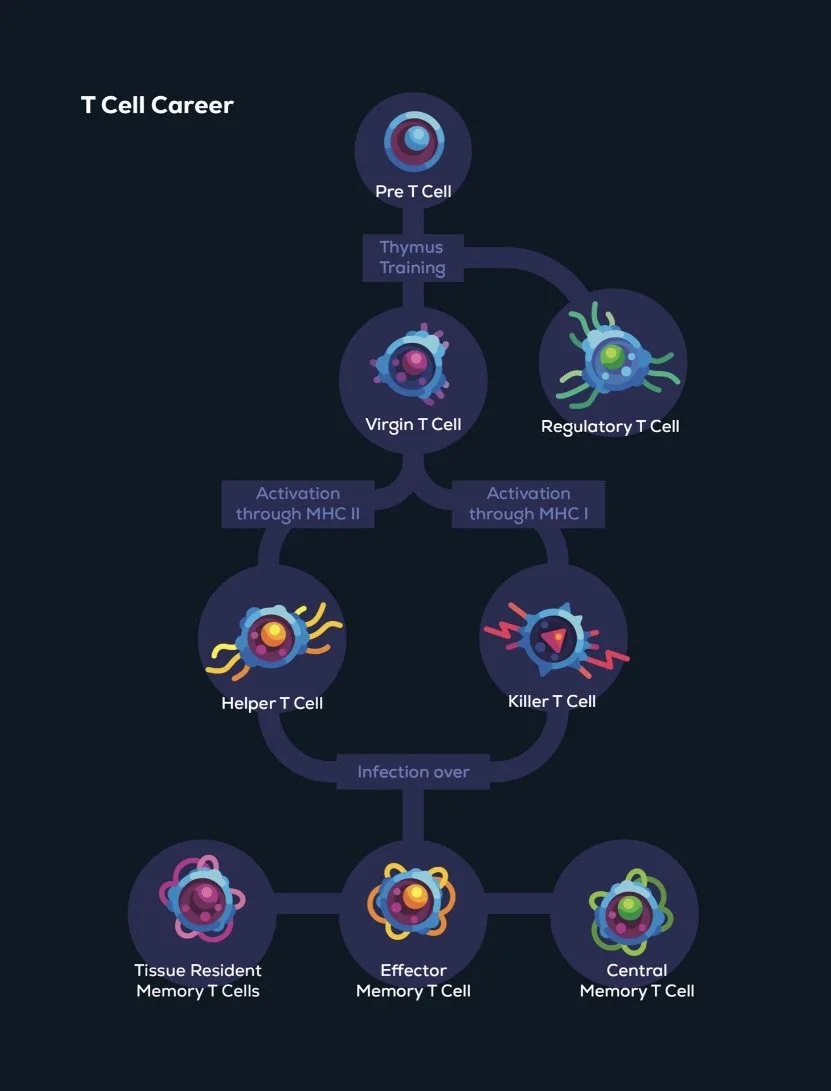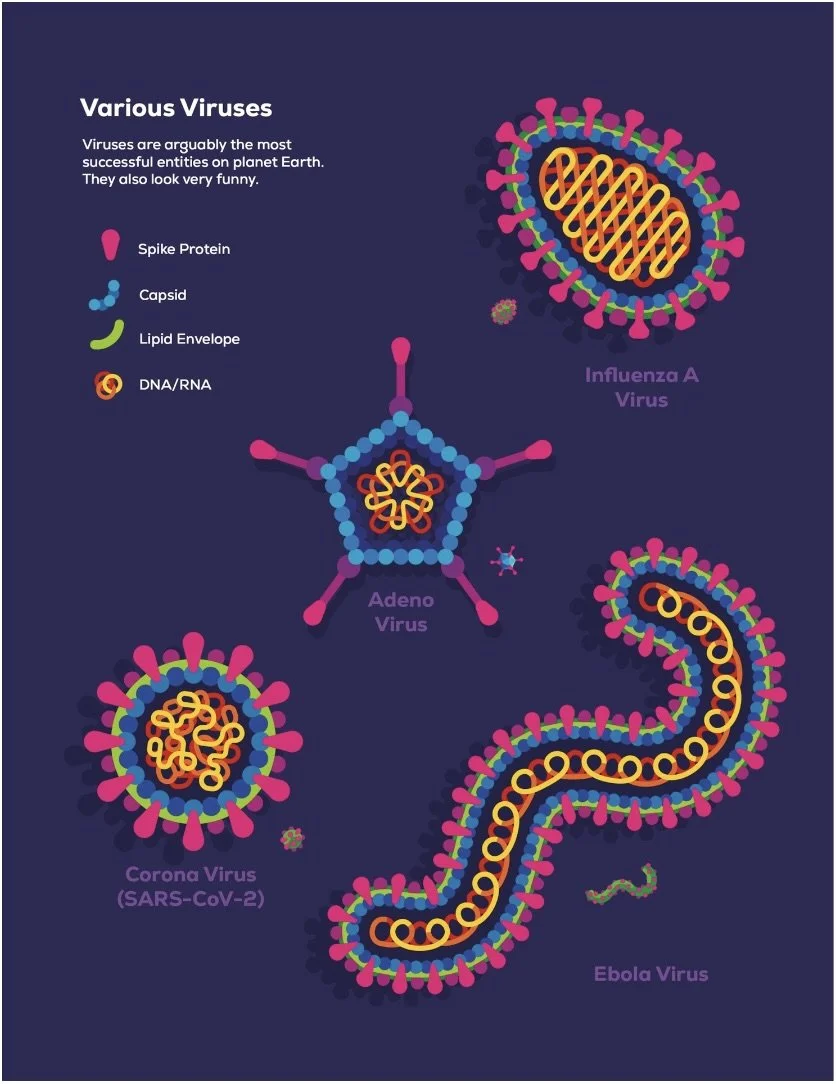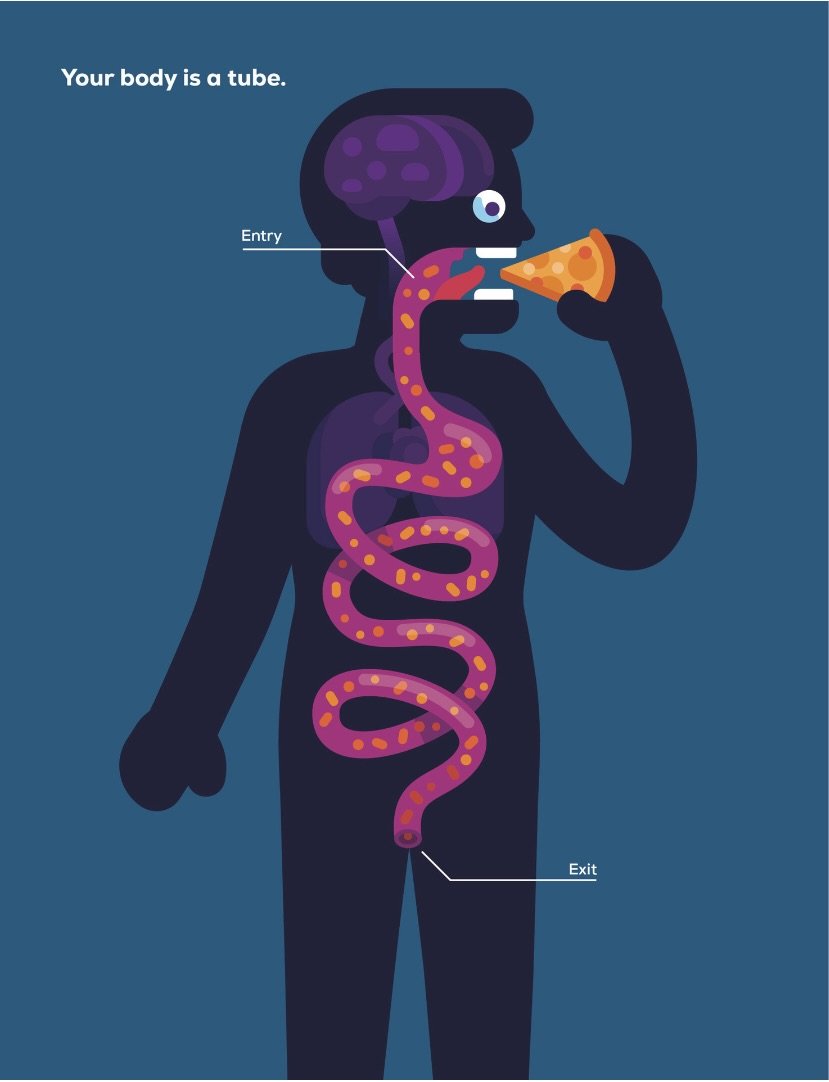Immune by Dettmer
Ref: Phillip Dettmer (2021). Immune. A Journey into the Mysterious System that Keeps You Alive. Hachette UK.
___________________________________________________________________________
Summary
The immune system is complicated in the sense that climbing Mount Everest is a nice stroll through nature.
While intruders roam your body, killing hundreds of thousands of your cells, your immune system is organizing complex defenses, communicating over vast distances, activating intricate defense networks, and dishing out a swift death to millions, if not billions, of enemies.
To most living things you are not a person but a landscape covered by forests, swamps, and oceans filled with rich resources and plenty of space to start a family and settle down. You are a planet, a home.
Immune System Response: Macrophages activate when they notice an enemy and release cytokines that call up neutrophils and cause inflammation. The neutrophils themselves release more cytokines, causing more inflammation and reactivating macrophages, who continue fighting. Complement proteins stream into the site of infection from the blood, attack pathogens, opsonize them, and help the soldier cells to swallow the enemies. Dendritic cells sample enemies and make their way to the lymph nodes to activate helper T cells or killer T cells, or both. Helper T cells stimulate the innate immune soldiers to continue fighting and create more inflammation. Killer T cells start killing infected civilian cells with support from natural killer cells. Meanwhile, activated B cells have turned into plasma cells and release millions of antibodies that stream onto the battlefield and disable the pathogens, maiming them and making them much easier to clear up. This is the immune response in a nutshell.
___________________________________________________________________________
What is the Immune System?
At its very core, the immune system is a tool to distinguish the other from the self…The goal above all things is maintaining and establishing homeostasis: the equilibrium between all the elements and cells in the body.
The Immune System may actually have been a side effect of single-celled organisms being mean to each other. As at one point one cell swallowed another but did not devour it. The “inside cell” (that we know as “mitochondria”) specialized in making energy available for the host, while the “outside cell” offered protection and delivered free food. This deal worked well and enabled the new super cell to grow in complexity and become more sophisticated.
The innate part does the actual fighting, but the adaptive part makes it more efficient with deadly precision.
___________________________________________________________________________
Your Cells?
Cells: Filled by proteins, which are 3D puzzle pieces. Their specific shapes enable them to fit together or interact with other proteins in specific ways. Sequences of these interactions, called pathways, cause cells to do things. The complex interactions between dumb and dead proteins create a less dumb and less dead cell, and the complex interactions between slightly dumb cells create the pretty smart immune system. Cells have a metabolism, meaning they take up nutrients from the outside and get rid of internal garbage. They respond to stimuli. They grow and can make more of themselves.
Organelles: The information center of your cell; a large structure with its own protective border wall that houses your DNA, your genetic code.
Mitochondria: Generators that transform food and O into chemical energy that keeps your cells running.
Proteins: Comprised of chains of amino acids. Proteins are the most fundamental organic building blocks and tools of all living things on this planet. They are so useful and manifold that a cell can use them for basically everything, from sending signals to constructing simple walls and structures to complex micromachines. Their specific shapes enable them to fit together or interact with other proteins in specific ways. Sequences of these interactions, called pathways, cause cells to do things. Proteins are used as messengers that convey information: They can receive or send signals that change their shape and trigger intensely complicated chain reactions.
Amino Acids: Tiny organic building blocks that come in twenty different varieties; comprised of strings of amino acids (a typical protein is usually made from between 50 and 2,000 amino acids).
Only one in a million to a billion possible amino acid combinations will yield a useful protein.
DNA: Your bodies instruction manual for building proteins, called genes. This occurs in a two-step process: Special proteins read the information on the DNA string and convert it into a special messenger molecule called mRNA—basically the language that our DNA uses to communicate orders. The mRNA molecule is then transported from the nucleus of the cell to another organelle, the protein production machinery called the ribosome. Here the mRNA molecule is read and translated into amino acids, that are then put together in the order inscribed into it. And voila, the cell has made a protein from your DNA. As these amino acid chains are made, they transform and change from a long 2D string into a 3D structure. This means that they are folding in on themselves in really complicated ways that we haven’t fully deciphered yet. Depending on the types of amino acids and the sequence they are put together in, the chain folds together into specific shapes. In the world of proteins shape determines what they can and can’t do.
Biological Pathways: The shape of your cells’ proteins determines which proteins attract or repel each other and how they interact (while the number of different types of proteins determines how often these interactions happen). This creates the interactions that make up the biochemistry of all cells on earth.
___________________________________________________________________________
---Innate Immune System---
Innate Immune System: Ready to fight after birth, and can identify if an enemy is not self, but other. It does the down-and-dirty hand-to-hand combat, but it also determines what broad category your enemies fall in and how dangerous they are. Its weapons are not tailored to identify any specific enemy, but instead they try to be effective across a wide range of common enemies. It has the power to activate your second line of defense: Your Adaptive Immune System.
The innate immune system when you get a cut:
Macrophages show up immediately; they devour dead cells and living enemies, coordinate defenses, and help heal wounds.
Neutrophils arrive shortly after; they begin hunting and devouring bacteria whole. Collateral damage is not their concern at this moment or ever, as the danger of bacteria spreading through the body is much too grave to consider civilians. But they do not only fight, they also self-sacrifice—some of them explode, casting wide and toxic nets around themselves in the process. These nets are spiked with dangerous chemicals that seal off the battlefield, trap and kill bacteria, and make it harder for them to leave and hide.
Platelets work to close the wound. They produce a sort of large, sticky net that clumps themselves and unlucky RBCs together and creates an emergency barrier to the outside world, stopping blood loss rather quickly and preventing more intruders from entering. This enables fresh skin cells to slowly start closing the enormous hole in the world.
Inflammation is ordered by the cells fighting at the site of infection to open up the blood vessels and let warm fluid stream into the battlefield, like a dam opening up towards a valley.
Dendritic Cells, stationed everywhere the skin can be penetrated, urgently begin collecting samples of the battlefield. Similar to Macrophages, Dendritic Cells have long tentacles to catch invaders and rip them into pieces. But their goal is not to devour them- they prepare samples made from the dead intruders, to present their findings to the intelligence centers of the immune system. After a few hours of sampling, the Dendritic Cells get on the move, leaving the battlefield behind to get help from the Adaptive Immune System. It takes the Dendritic Cell about a day to reach its destination.
___________________________________________________________________________
Macrophages
Macrophages (‘Great Eaters’): A phagocyte (‘eating cell)’; the first responders of the innate immune system. They devour dead cells and living enemies, coordinate defenses, help heal wounds, and cause inflammation. The macrophage is equipped with an abundance of compartments that are filled with the equivalent of stomach acid- substances that dissolve things. These compartments merge with the tiny prison and pour their deadly contents all over the victim, dissolving it into its components, into amino acids, sugars, and fats that are not only harmless, but even useful.
Dead cells attract Neutrophils and if they find a single dead cell, they will escalate the situation and cause even more damage that is not necessary. So, to stop them from that, Macrophages can sort of cover a single dead cell with their body to literally hide it from Neutrophils, so they are confused and leave again.
An activated Macrophage can swallow up to 100 bacteria before it dies of exhaustion.
When an infection has been dealt with, Macrophages can slow or even shut down the immune response at the site of battle to prevent further damage.
___________________________________________________________________________
Neutrophils
Neutrophils: A phagocyte (‘eating cell’); part of the innate immune system that throws acid at enemies, kills themselves to create deadly traps, and causes inflammation. Neutrophils are densely packed with granules, which are basically tiny packages filled with a deadly load that cuts into pathogens. When a neutrophil encounters a pathogen, it will shower them with granules that rip their outsides apart, which, unfortunately, can also damage our own cells. They do not only fight, they also self-sacrifice—some of them explode, casting wide and toxic nets around themselves in the process. These nets are spiked with dangerous chemicals that seal off the battlefield, trap and kill bacteria, and make it harder for them to leave and hide. Neutrophils are by far the most abundant immune cell in your blood and easily one of the most potent. Neutrophils are on a tight timer and only live a few days when they are not needed before they commit controlled suicide.
Neutrophil Extracellular Trap (NET): If neutrophils get the impression that drastic measures are called for, they begin this crazy kind of suicide. First their nucleus begins to dissolve, freeing up their DNA. As it fills up the cell, countless proteins and enzymes attach to it. And then the Neutrophil literally spits out its entire DNA around itself, like a giant net. Not only can this net trap enemies in place and hurt them—it also creates a physical barrier that makes it harder for bacteria or viruses to escape and move deeper into the body.
Pus: The dead bodies of millions of neutrophils that fought to the death for you, mixed in with ripped-apart remains of civilian cells, dead enemies, and spent antimicrobial substances.
___________________________________________________________________________
Dendritic Cells
Dendritic Cells: Cells of the immune system that identify what kind of enemy is infecting you. They make the decision to activate the next stage of your defense: Your adaptive immune cells, your heavy, specialized weapons that need to come in if your innate immune system is in danger of being overwhelmed. Dendritic cells deliver context to the adaptive immune system by sampling the battlefield and delivering those samples to the lymph node. To get there, the Dendritic Cell has to enter the Immune System Superhighway: The Lymphatic System. Dendritic Cells that are charged up with the snapshot of a battlefield from a virus infection are basically able to call for three different types of reinforcements: They activate the specific Killer T Cells that kill infected cells, and they activate Helper T Cells that help out at the battlefield and Helper T Cells that activate B Cells to provide antibodies.
When an infection happens it covers itself with a selection of the enemy’s antigens and tries to find a Helper T Cell that is able to recognize one of the antigens with its specific receptors. And this is exactly the reason why the Dendritic Cell is so crucially important. Without Dendritic Cells, there would be no second line of defense.
Dendritic cells are in a constant sampling mode. Even if there is no danger, a few of your dendritic cells, for example in your skin, will take samples of the stuff floating around in the natural, healthy environment between your cells—a lot of it is self-antigen presumably—and then move to your lymph nodes to show the adaptive immune system what it found.
Dendritic cells conduct cross-presentation, which enables them to sample virus antigens and to present some of them in their MHC class I molecules, in their display windows, even though they have not been infected by a virus. So Dendritic Cells are able to activate Helper T and Killer T Cells at the same time.
Plasmacytoid Dendritic Cells: Special cells that spend their lives moving through your blood or camp out in the lymphatic network, scanning specifically for signs of viruses—panic interferons from civilian cells or just straight up viruses that float around in your fluids. If they do pick up signs of a viral infection, they activate and turn into chemical power plants that ooze out extreme amounts of interferons, alerting not only civilians to turn on their antiviral modes (shut down protein production, etc.) but also the immune system to activate.
___________________________________________________________________________
Monocytes
Monocytes: Reinforcement cells that can transform into Macrophages and Dendritic Cells. About half of them patrol in your blood right now where they represent the largest single cell that floats through your cardiovascular system. If you suffer an injury and an infection that drains and kills a lot of your Macrophages, they come in as backup. Once they enter the site of infection, they stop being Monocytes and transform into fresh Macrophages.
___________________________________________________________________________
Receptors
Receptors: Cells have millions of noses on their outsides that are called receptors. They cover the outside of cells and perform all sorts of function, from taking in certain nutrients to communicating with other cells or as triggers for a variety of behaviors. In a simplified way, receptors are sort of the sensory organs of cells that let the insides of the cells know what happens on the outside. They communicate by releasing proteins that carry information, called cytokines. When a cell smells cytokines with their receptors (noses), they trigger pathways inside the cell that change their gene expression and therefore the behavior of the cell.
___________________________________________________________________________
Cytokines
Cytokines: Very small proteins that transmit information, activate cells, lead cells to the site of a skirmish, or make immune cells change their behavior. If one of your cells realizes that it is infected by a virus, it immediately releases a number of different emergency cytokines to the cells surrounding it and to the immune system. There are hundreds of different cytokines and they are important in almost every biological process going on inside of you—from your development in your mother’s womb to the degeneration you experience as you get older.
Interferons: A type of cytokine that interferes with viruses. Interferons are the ultimate “get ready for a virus” signal. A spike of interferons in your blood is usually the earliest sign of a virus infection. When cells pick up interferon molecules, it triggers different pathways that make them change their behavior drastically. One of the first changes is for the cells to temporarily shut down protein production.
Chemokines (‘Move Chemical’): A family of small cytokines secreted by cells; their main ability is to motivate cells to move in a certain direction.
Pyrogens (‘creator of heat’): Chemicals that cause fever- a systemic, body wide response that creates an environment unpleasant for pathogens and enables your immune cells to fight harder. Pyrogens, a type of cytokine, are released by soldier cells that realize they are dealing with a viral infection and require help on a larger scale.
Macrophages and other cells release Cytokines, that carry the information purely by the random motion of particles in your bodily fluids. Somewhere else, another immune cell, maybe a Neutrophil, smells these cytokines up and “receives” the information. The more cytokines it picks up, the stronger it reacts to them. The closer to the origin of the source of a smell a cell is, the more cytokines it will pick up. By measuring the concentration of cytokines in the space around it, it can precisely locate where the message is coming from and then begin moving in that direction. It is sort of “smelling” where the smell is the most intense. Which will lead it to the site of battle. One single nose will yield no reaction. A few dozen noses smelling something will get an immune cell mildly excited. But a few hundred or even thousands will rile it up pretty intensely and make it react with striking violence! This principle is extremely important. A signal needs to pass a specific threshold to compel a cell to do something. If there are too many cytokines the immune system can lose all constraint, become super enraged, and overreact massively—which leads to an appropriately named cytokine storm. This is nothing more than way too many immune cells releasing way too many cytokines even if there is no danger.
___________________________________________________________________________
Natural Killers
Natural Killer (NK) Cells: One of the few cells with an official license to kill your own body cells. NK Cells hunt two types of enemies: cells infected by viruses and cancer cells. They check if a cell has MHC class I molecules.
Many viruses force infected cells to stop showing them as part of their invasion strategy, and many cancer cells just stop putting up display windows, thus making them invisible to the antiviral immune response that we have shown thus far. The Adaptive Immune System is now suddenly harmless to these cells. The NK Cell just checks for one thing: Does a cell display a window? It does? “Great, please carry on, sir!” It doesn’t? “Please kill yourself immediately!” While the rest of the immune system looks for the presence of the unexpected, the presence of something other, NK Cells look for the absence of the expected, the absence of self. This principle is called “The Missing-Self Hypothesis.”
___________________________________________________________________________
Inflammation
Inflammation: Restricts an infection to an area to stop it from spreading, but also to help remove damaged and dead tissue and to serve as a sort of expressway for your immune cells and attack proteins directly to the site of infection. Inflammation is a process that makes the cells in blood vessels change their shape, so that plasma, the liquid part from your blood, can flood into a wounded or infected tissue. You can imagine inflammation as a floodgate opening and a tsunami of water, filled with salts and all sorts of special attack proteins, flooding the spaces between your cells so rapidly that tissue on the scale of a metropolitan area balloons up. Wherever your cells suspect that something fishy is going on they order inflammation as a dramatic first response. Inflammation has five markers: Redness, heat, swelling, pain, and loss of function.
The first way inflammation gets started is through dying cells. Amazingly, your body evolved a way to recognize if a cell died a natural way or if it died a violent death. The immune system has to assume that cells dying an unnatural death means grave danger, and so death is a signal that causes inflammation.
According to pretty new science, chronic inflammation is involved in more than half of all deaths each year as it is an underlying cause of a wide variety of diseases—from various cancers to strokes or liver failure. And yes, you read that correctly—for at least one in two people who died today, chronic inflammation was the underlying cause of the disease that killed them.
If you hurt yourself and tissue is destroyed and they die or they get really agitated, Mast Cells release their inflammation supercharger chemicals and speed up the process immensely. The next best way to cause inflammation is more of an active decision: Macrophages and Neutrophils order inflammation when they are engaged in a battle. There are a few areas in your body that are excluded from this rule, like your brain, spinal cord, part of your eyes, and testicles. All are extremely sensitive regions where inflammation could cause immediate, irreparable damage and so these areas are so-called immune privileged, which means that cells of the immune system are kept out of there by the blood-tissue barriers.
Mast Cells: Large, bloated cells filled with tiny bombs containing extremely potent chemicals that cause rapid and massive local inflammation. (For example, the itching you feel when a mosquito bites you was probably caused by chemicals the Mast Cell released.) They mostly sit below your skin and do their thing.
___________________________________________________________________________
---Complement System---
Complement System: Comprised of >30 different positively charged proteins that anchor themselves to negatively charged bacteria and activate/guide immune cells to invaders; one of the oldest parts of the immune system.
___________________________________________________________________________
---Adaptive Immune System---
Adaptive Immune System: Requires a few years of life before it is ready to deploy efficiently. It is specific and can draw from an incredibly large library to fight every possible individual enemy that nature can throw at it, with powerful superweapons. It contains factories that produce heavy protein weapons and special cells that hunt and kill infected body cells in the case of viral infections. Its defining feature is that it is specific. But while it is powerful, one of its most important jobs is to make the Innate Immune System even stronger.
The immune system does not so much adapt to new invaders as it already was adapted when you were born. It comes preinstalled with hundreds of millions of different immune cells—a few for every possible threat that you could possibly encounter in this universe.
The adaptive immune system is mixing gene segments to produce an amazing variety of different receptors, able to connect to every possible protein, in this context called an antigen, in the universe. This means that each individual T Cell is born with ONE specific type of receptor, able to recognize ONE specific antigen.
The Adaptive Immune System in Action
Dendritic Cells sample the battlefield for the first few hours of an infection, collecting information about the enemy, swallowing them and disassembling their parts, or antigens.
The onslaught of battle chemicals, cytokines, and dead or dying cells makes you exhausted and causes all sorts of unpleasant body sensations.
Covered in guts, the dendritic cell travels through the lymphatic system to the nearest lymph node to present them to Helper T Cells, where they have a week to find and activate a T-Cell before apoptosis.
It takes ~2-3 days until NK Cells show up and begin to alleviate your desperately fighting immune soldiers.
Dendritic cells activate Killer T Cells and Helper T Cells that then go on to activate B Cells and order Antibodies.
About a week after you collapsed into bed, your heavy artillery finally arrives. Killer T Cells flood in by the thousands, armed with receptors that recognize the antigen, moving from cell to cell and taking them into a warm embrace, taking a deep look into the MHC class I windows, listening to the protein story that the cells tell. If they detect virus antigens, they order the infected cells to kill themselves.
Macrophages work overtime to eat up all their dead friends and foes.
Neutralizing antibodies neutralize the virus by connecting firmly to the structures that the virus used to gain access into cells. Covered by dozens of antibodies that block the virus from entering cells, it is now nothing more than a useless and harmless bundle of genetic code and proteins that will eventually be cleaned up by your Macrophages.
___________________________________________________________________________
T-Cells
T (‘Thymus’) Cells: Immune cells of the adaptive immune system that start their lives in the bone marrow, where they mix and match the gene fragments that create their unique T-cell receptors, before they attend the murder university of the Thymus. T-Cells include Helper T Cells, Killer T Cells, and Regulatory T Cells.
Helper T-Cells: Specialist T-cells of the adaptive immune system forged to fight a specific pathogen. Helper T-cells are able to recognize an antigen only if it is presented in an MHC class II molecule from an antigen-presenting cell. They arrive at the site of infection after ~5d-1w where they begin to act as local commanders. Although Helper T Cells don’t do any active fighting themselves, they considerably boost the fighting ability of the local defense cells. For one, they release important cytokines that have a diverse set of jobs, from calling for more reinforcements to increasing inflammation. Helper T Cells can reset the Macrophage suicide timer over and over again. When the battle is won, the last thing most Helper T Cells do at the battlefield is to kill themselves to protect the body from themselves. Except, a few don’t. Some Helper T Cells become Memory Helper T Cells. Whenever you hear that you are immune to a disease, it means that you have living memory cells that remember a specific enemy. In case of another infection, this makes the long trip of the Dendritic Cell to the lymph node unnecessary because these Memory Helper T Cells can immediately activate and call for heavy reinforcements.
Killer T Cells: ~40% of the T cells in your body; come with billions of possible different and unique receptors for all sorts of possible antigens. They have to pass the education of the Murder University of the Thymus before they are allowed to enter general circulation. Killer T Cells depend on the display windows (MHC class I molecules) to get activated. To truly awaken, Killer T Cells need a second signal. The second activation signal comes from a Helper T Cell. When a Killer T Cell finds a cell that has virus antigen in its display window (MHC class I receptors) it immediately issues a special command to the cell: “Kill yourself but be very clean about it.” In this case, the Killer T Cell punctures the infected cell and inserts a special death signal, that is conveying a very specific order: Apoptosis. This way the virus particles are neatly trapped in tiny packets of cell carcass and unable to do further damage until a hungry Macrophage passes by and consumes the remnants of the dead cell. This process is extremely efficient and the virus count drops harshly as thousands of Killer T Cells move through the battlefield, checking every cell they meet for infection, in a process that is called “serial killing.”
Many viruses force infected cells to stop making MHC class I molecules, effectively destroying this strategy.
Regulatory T Cells: ~5% of T Cells. They can order Dendritic Cells to become worse at activating the Adaptive Immune System or they can make Helper T Cells slow and tired, so they don’t proliferate as much. They can turn Killer T Cells into much less vicious fighters, shut down inflammation, and make it recede faster. In a nutshell, they can end an immune reaction or just prevent it from being triggered in the first place.
Tissue-Resident Memory T Cells: After an infection is over, about 90% of all T Cells who fought at the site of the infection will kill themselves. The remaining 10% will turn into Tissue-Resident Memory T Cells, and become silent guardians. These Memory T Cells are dormant sleeper agents, that lie and wait without doing anything. If they ever spot the intruder again, they will awaken and attack and activate the surrounding immune cells immediately though.
Effector Memory T Cells: For years they patrol the lymphatic system and your blood, not causing trouble, just looking for the antigen that once activated the cell that was their ancestor.
Central Memory T Cells: Cell that remain stationary in your lymph nodes, doing nothing but keeping the memory of the attack. When activated they quickly produce massive amounts of new Effector T Cells that go on the attack right away.
T-Cell University (Thymus)
First Test: Ensuring that T Cells have the ability to make working T Cell receptors.
Second Test (Positive Selection): Teacher cells check if the T Cells are really good at recognizing the receptors of the cells they will need to work with.
Third Test (Negative Selection): Can the T Cell recognize self? The teacher cells in the Thymus that do the testing have a special license to make all sorts of special proteins that usually are made only in organs like the heart, pancreas, or the liver and also hormones, like insulin for example. This way they can show the T Cell all kinds of proteins that are marked as “self.” If a T Cell is able to recognize any of these self-proteins, they are taken out back and shot in the head immediately.
Roughly 10-20M T cells leave your Thymus daily. They represent the successful 2% of survivors from T-cell tests. These survivors are so diverse that you end up with at least one T Cell that can recognize basically every possible enemy that the universe could throw at you.
Every year the Thymus cells turn into fat cells or just worthless tissue. The university closes more and more departments and gets worse as you age, until around 85yo, your T Cell university closes its gates for good. The absence of the immune cell university is one of the most important reasons why seniors are much weaker and more susceptible to infectious diseases and cancer than younger people.
Technically no T Cell is killed in the Thymus. To be more correct would actually be that they are told to kill themselves by the teacher cells. There are a lot of Macrophages in your Thymus and their job is to eat all the unlucky fellows who did not pass the test.
Clonal Selection Theory: Your activated T Cell leaves the Dendritic Cell that activated it behind and wander to a different part of the Lymph Node City where it begins the process of cloning itself.
Anergy: The immune systems deactivation of T-cells that are able to recognize your own cells.
___________________________________________________________________________
B-Cells
B Cells: Originate in the bone marrow and undergo the same brutal and deadly education as the T-Cells (only not in the Thymus, but in the bone marrow). Just like the T Cell, all your B Cells combined come with at least hundreds of millions to billions of different receptors for millions of different antigens. And just like T Cells, every single individual B Cell has one specific receptor that is able to recognize one specific antigen. What makes B Cells special, and very dangerous for friends and foes, is that they produce the most potent and specialized weapon the immune system has at its disposal: Antibodies.
Memory B Cells: Adaptive immune system cells that require two activation signals to truly activate. The first one is delivered by antigen floating through the lymph nodes, and it leads to moderately activated B Cells. But if an activated Helper T Cell joins the party, it can deliver signal number two and confirm that the infection is serious, which activates the B Cell in earnest.
Plasma Cell: A Memory B Cell that has been activated first from an antigen floating through the lymph nodes, and second, through activation by a Helper T Cell. Plasma cells rapidly make lots more of themselves and produce antibodies.
Long-Lived Plasma Cells: A type of plasma cell that has received activation from both an antigen and a Helper T Cell that wanders into your bone marrow and remain for months and years, where they constantly make a new Antibodies. Their entire job is to make sure that specific Antibodies against enemies we fought off in the past are always present in your bodily fluids.
Memory B Cells settle down in your lymph nodes after they are activated, and just chill. For years and years they are inactive and just silently scan the lymph for the antigen they remember. If they ever catch an antigen they awake suddenly and very rapidly proliferate and make thousands of clones of themselves that don’t need Helper T Cells to properly activate but start as Plasma Cells that immediately begin to produce millions of Antibodies en masse.
B Cell Activation (B Cells can only be fully activated by two factor authentification)
1) A battle needs to occur and dead enemies, which are big chunks of antigens (turkey drumsticks), need to float through the lymph node. Here, a B Cell, with a specific receptor needs to connect to the antigen. B Cells also have special receptors that are able to recognize complement proteins, so if the dead enemy is covered in complement, activation will be much easier. This will activate the B Cell and it will move to another area of the lymph node where it makes a lot of copies of itself. This cloning continues until there are roughly 20,000 identical clones, all with copies of the specific receptor that was able to connect to the original antigen, the first virgin B Cells picked up. These B Cell clones begin producing Antibodies that use the blood as a lift to the site of infection and can flood the battlefield and help out—although they are second-rate antibodies.
but the B Cells will die after around a day if nothing more happens.
2) In the meantime, a Dendritic Cell needs to pick up enemies at the battlefield and turn them into antigens (wieners) which are put in the MHC class II molecules (hot dog buns) and travel to the T Cell dating area in the lymph node. Here it needs to find a Helper T Cell that is able to recognize the antigen with its unique T Cell receptor (eat the wiener from the bun). If this happens the Helper T Cell is activated and makes a lot of copies of itself.
3) The B Cell breaks the big chunk of antigen (turkey drumstick) down into dozens or hundreds of small antigens (wiener sized) and begins presenting them in MHC class II molecules (hot dog buns).
4) An activated B Cell that is presenting hundreds of different antigens (wiener-sized sausage pieces) needs to meet a T Cell that can recognize one of these antigens with its specific T Cell receptor, which is the second signal for the B Cell. Only if this exact sequence of events occurs does a B Cell get activated for real.
5) Your properly activated B Cell swells to nearly double its size, and transforms into a plasma cell. The Plasma Cell now begins producing antibodies for real. It can release up to 2,000 antibodies per second that saturate the lymph and blood and the fluids between your tissue.
Somatic Hypermutation (‘Affinity Maturation’): Purposeful mutation of a B cell every time it receives a positive signal from a helper T cell. B Cells continually bathe their new and improved receptors in the stream of lymph from the battlefield to refine their antibodies. If mutations improved the B cell receptor, it will now be even better at recognizing the antigen and the B cell will get an activation signal again.
___________________________________________________________________________
Antibodies
Antibodies: Produced by B cells, antibodies are stuck to the surface of B Cells and work as their B Cell receptors, which means that they can stick to an antigen and activate the cell. Once a B Cell is activated it begins to produce thousands of new Antibodies and starts to vomit them out, so they can attack your enemies, ~2,000 per second. Antibodies maim and disarm specific pathogens that are present at the site of infection.
Like a magnet, antibodies will seek out antigens and grab their victim with their tiny pincers. And once an antibody has attached itself, it will not let go again; basically, tiny crab-like proteins that are extremely good at grabbing on to the enemies they were made for. Antibodies do multiple things: First, similar to complement, they can opsonize enemies (antibodies swarm an enemy and grab them). As soon as an antibody has grabbed a victim with its tiny pincers, its butt changes its shape and is now able to bind to immune cells. Antibodies are able to activate the complement system and sort of attract it to bacteria.
A single drop of your blood contains about 13,000,000,000,000 Antibodies. A protein memory of all the challenges you overcame in your life.
B Cells always start by making IgM Antibodies but can switch the antibody type if the Helper T Cell asks and encourages them to! Having a nasty cold or a gut infection and need a lot of antibodies in your snot or stool? Make IgA! Having a parasitic worm in your intestines? Make IgE! A lot of bacteria have infected a wound? Make IgG flavor one! There are a lot of virus-infected cells? Please, more IgG!
IgM Antibodies: The majority of antibodies B cells produce when activated. They are the first defenders on site. IgM is basically five Antibodies merged together at the hips, which has the advantage that they have five butt regions. Two of these butt regions together can activate an additional complement pathway. With their ten pincers they can clump them together easily.
IgG Antibodies: Specialist antibodies produced by B cells. IgG is really good at opsonizing a target and just covering it like an army of fruit flies, making it harder for a bacterium to do its thing and to function properly. Its tiny butts are like special glue that your phagocytes can grab on to easily and devour an enemy with much less resistance.
Special IgG Antibodies are specifically made to be unable to activate the complement system late in an infection, which limits inflammation.
IgG Antibodies are the only Antibodies that are able to pass from the blood of a mother into the blood of an unborn fetus via the placenta. IgG is the antibody that takes the longest to decay, so it gives a newborn human a passive defense against virus infections that protects it in the first few months until its own immune system has a chance to properly boot up by itself.
IgA Antibodies: The most abundant antibody in your body and its main job is to serve as a cleanup mechanism for your mucosa. IgA are abundant in your respiratory tract, your primary sexual organs, and especially in your digestive tract, including your mouth. Here, a great number of special B Cells produce large amounts of these special antibodies. IgA are the only antibodies that can freely pass the internal border of the Mucosa kingdom from the inside to saturate our mucosa on the outside.
IgA have their little butts merged together, which means that IgA can’t activate the complement system at all.
IgE Antibodies: Responsible for allergic reactions to things that are harmless. The original purpose IgE antibodies serve is to protect you against infections by huge enemies: parasites, especially worms.
IgD Antibodies: Help activate a bunch of immune cells.
___________________________________________________________________________
MHC Class I & II
Major Histocompatibility Complex Class I (MHC Class I): The cell’s display windows; cells are constantly breaking down their proteins so their parts can be recycled and reused. The crucial thing here is that while this recycling happens, your cells pick a random selection of protein pieces and transport them to their membranes to display them on their surfaces. The MHC class I molecule showcases these proteins to the outside world, just like a fancy display window would showcase a selection of the items the inside of a store has to offer.
Cells have many thousands of display windows—or many thousands of MHC class I molecules—and each one gets refreshed with a new protein, about once a day. There are cells going through your body right now, checking these windows on random cells, making sure there is no funny business going on inside them.
The number of MHC class I molecules is not fixed. One of the most important things that happens during the chemical warfare triggered by interferon is that cells are stimulated and ordered to make more MHC class I molecules. So, in case of an infection, interferon tells all cells in the vicinity to build more windows and become more transparent, to tell more of their internal protein story and be more visible to the immune system.
Red Blood Cells (RBCs): The only cells in your body that don’t have MHC class I receptors.
With malaria, the parasite plasmodium infects RBCs and NK cells cannot check these cells for windows.
Major Histocompatibility Complex Class II (MHC Class II): Presents antigens (hot dogs) to other immune cells to activate or simulate them. Only antigen-presenting cells have MHC class II molecules. This includes Dendritic Cells, Macrophages, and B Cells.
The genes that are responsible for the MHC molecules are the most diverse genes in the human gene pool, leading to a huge variety of MHC molecules between individuals. Aside from the intuitive level that might feel correct to you, there have been an abundance of studies that showed that all sorts of animals—including humans—prefer the smell of mates with MHC molecules that are different from their own. We just find that if a potential mate has a different immune system, he or she smells sexier. This extra attraction is also a mechanism that avoids inbreeding by making your biological siblings not smell attractive on a sexual level and decreases the chances of close family members getting involved with each other.
___________________________________________________________________________
---The Immune System and the Body---
___________________________________________________________________________
Lymphatic System
Lymphatic System: The Immune System’s superhighway; drains your body and tissues of excess fluid and delivers it back to the blood where it can circulate again. The Lymphatic System is also your fat transportation system. It picks up food fats around your intestines and dumps them into the bloodstream to be further distributed.
Lymph: The fluid transported through the lymphatic system.
Lymph Nodes: The immune systems bean-shaped intelligence centers. You have ~600 of them spread all over your body.
Spleen: A sort of large lymph node, about the size of a peach but bean shaped that filters your blood. ~90% of old blood cells are filtered and recycled in the spleen when their life comes to end. On top of that your spleen stores an emergency reserve of blood, about a cup, which is invaluable if something bad happens and you could use a bit of extra blood in your body. This is still not all, 25 to 30% of your RBCs and 25% of your platelets are stored here for emergencies.
Tonsils: A lymph node and center of immune system intelligentsia in your mouth that actively samples what comes into your body. To get samples to them, your tonsils have deep valleys where tiny pieces of food can get stuck. Microfold Cells, very curious cells that grab all sorts of stuff from your mouth and pull it deep into the tissue, where they show it to the rest of the immune cell to check out.
___________________________________________________________________________
Skin
Skin Cells: Your skin cells begin ~1mm deep. In the basal layer, stem cells do nothing but calmly multiply. The skin stem cells constantly make new skin cells, and each new generation pushes the older ones further up. So your skin cells are constantly pushed upward by younger skin cells emerging below them. Your skin cells begin manufacturing lamellar bodies, tiny bags that squirt out fat to create a waterproof and impermeable coat that covers the cells and the little bit of space that is left between them. This coat does three things: It acts as another physical border that is extremely hard to pass; it makes it easier to dispose of dead skin cells later on; and it is filled with natural antibiotics called defensins. Depending on your age, it takes your skin between 30-50 days to completely turn over.
Keratin: A tough protein produced by the skin cells to make up the hard part of your skin, nails, and hairs.
From the perspective of a bacteria, the skin is a dry and salty desert filled with geysers that spit out toxic fluid and flush enemies away…The inside and outside of your body have different pH levels. So if a bacterium adapts to the acidic environment on the skin and then gets an opportunity to enter the bloodstream, for example, through an open wound, it has a problem: Your blood has a higher pH. So the bacterium suddenly finds itself in an environment that it is not adapted to.
Overall, an average sqcm of your skin is home to ~1M bacteria (~10B friendly bacteria in total populate your outsides right now).
The way the skin is built, it is practically immune against viruses. Because these little parasites can infect only living cells and the surface of your skin consists only of dead cells.
Your body is wrapped in an ingenious self-repairing border wall that is incredibly hard to pass and that protects you extremely efficiently. If it is breached, your Innate Immune System reacts immediately. First your black rhinos, Macrophages, huge cells that swallow enemy’s whole, appear and dish out death. If they sense too many enemies they use cytokines, information proteins to call your chimp-with-machine-gun Neutrophils, the crazy suicide warriors of the immune system. Neutrophils don’t live long and their fighting is harmful to the body because they kill civilian cells. Both of these cells cause inflammation, bringing in fluid and reinforcements to an infection, making a battlefield swell up. One of the reinforcements is complement proteins, an army of millions of tiny proteins that passively support the immune cells in their fight and help mark, attach to, maim, and clear enemies. These powerful teams together are enough for most small wounds and infections you encounter.
___________________________________________________________________________
Mucosa
Your real weak points to infections are your mucous membranes—the surface that lines your windpipe and lungs, eyelids, mouth, and nose, your stomach and intestines, your reproductive tracts and bladder.
Mucosa (‘Inside Skin’): Produced by goblet cells; covers the lining of the lungs, guts, mouth, and respiratory and reproductive tracts. The first line of defense against pathogens. Mucus is a slippery and viscous substance that behaves a little bit like watery gel. You know it as the slimy stuff in your nose that becomes especially visible and disgusting when you have a cold—but it is actually all over your insides—in your gut, your lungs, your respiratory system, your mouth, the inside of your eyelids, etc. Mucus is not just a sticky barrier but also filled with unpleasant surprises similar to the desert kingdom: salts, weaponized enzymes that can dissolve the outsides of microbes, and special substances that sort of sponge up crucial nutrients that bacteria need to survive, so they starve to death inside the mucus. In most places your mucus is also saturated with deadly IgA Antibodies.
Epithelial Cells: A vast network of fine cilia, tiny organelles that look a bit like hair, that cover the membranes of the special cells that make up the first layer of the mucous membrane. These cells are the equivalent of your skin cells.
Your epithelial cells have a bunch of different receptors that scan their own insides for red flags.
___________________________________________________________________________
Gut
On your gut mucosa, ~30-40T individual bacteria from around 1,000 different species and tens of thousands of species of viruses make up your gut microbiota (the vast majority of viruses in your gut are hunting the bacteria living there and not interested in you)…Mucosa inside your stomach acts as a barrier that keeps the acid at a distance and protects the cells making up your stomach wall.
Commensal Bacteria: ‘Together at the same table’: Latin; millions of years ago our ancestors made a fragile deal with a team of microbial species—humans provide them with a long, warm tunnel to live in and a constant stream of stuff they can eat, and in turn they break down carbohydrates that we can’t digest and produce certain vitamins that we can’t make ourselves.
Intestinal Epithelial Cells: Epithelial cells that lay below the mucus layer of the intestines, the actual barrier between the inside and the outside. Similar to your lungs, the layer of epithelial cells protecting your insides is only ONE cell thick. Intestinal epithelial cells are extremely well-connected with each other. Special proteins glue them together firmly, so they can be as good a wall as possible.
Lamina Propria: The third layer of the gut mucosa that lies below the epithelial wall, the home of most of the immune system of your gut. In the Lamina Propria, directly below the surface, special Macrophages, B Cells, and Dendritic Cells are waiting to greet the unwelcome guests.
Your intestinal immune system really does not want to cause inflammation if not absolutely necessary, because inflammation means a lot of extra fluid in the intestines, which you experience as diarrhea. Our bodies and immune systems learned to take inflammation in the intestines very seriously. As a consequence, the Macrophages guarding your intestines have two properties: Firstly, they are really good at swallowing bacteria. And secondly, they do not release the cytokines that call in Neutrophils and cause inflammation.
Peyer’s Patches: A special type of lymph node integrated into your intestines to stop pathogenic bacteria that reach the intestines intact.
Microfold Cells: Reach directly into the intestines and take samples of things they think might be interesting for the immune system to take a look at. In a way, they are a sort of elevator cell that picks up passengers and transfers them directly into the Peyer’s patch, where adaptive immune cells check out everything that goes on in your gut (similar to those found in your tonsils).
___________________________________________________________________________
Lungs
Each breath takes in about a pint (500 mL) of air, made up not only of the O you need but also a few other gases that your body doesn’t care about, and a plethora of particles. Your alveoli, tiny sacs full of air, can’t be covered by mucosa or breathing would not be possible. So, at your deepest and most vulnerable places in your lungs, there is literally only a single layer of epithelial cells between the inside and the outside and nothing else. Talk about an exposed area. A perfect target for all sorts of pathogens.
Alveolar Macrophage: A cell of the innate immune system that patrols the surface of your lungs and picks up trash. Most detritus and other unpleasant stuff are caught in the mucosa of the upper respiratory system, but some of it still reaches the deeper parts. Alveolar Macrophages are extra-chill Macrophages. They are much harder to provoke and activate than their cousins in your skin. In airways they downregulate other immune cells like Neutrophils and make them less aggressive. But most importantly, they tone down any sort of inflammation. Because the thing you really don’t want in your lungs is fluid.
___________________________________________________________________________
Megakaryocytes & Platelets
Megakaryocyte: Enormously large cells (~6x larger than your average cell) that live in your bone marrow. They have very long octopus-like arms that they push into your blood vessels and begin to grow them. When one of these weird arms has grown enough, small packages break off. Functional mini parts of cells that are carried away by the blood. These packages are your platelets. A single megakaryocyte produces around 10,000 of these platelets in its lifetime from its flabby long arms that stretch from your bones to into your blood.
Platelets: Packages broken off from the arms of megakaryocytes that help to seal wounds.
___________________________________________________________________________
Pregnancy & Motherhood
Today a considerable percentage of babies are born via cesarean section. This is not ideal because in regular births the tiny human comes in close and intense contact with the vaginal and often fecal microbiome of their mother. So, your birth is actually an important step in the microbial priming of your body and immune system.
Mothers’ breast skin and milk contain a vast and diverse array of substances that nurture the very young microbiome and a number of diverse bacteria.
Both C-sections and the lack of breastfeeding are correlated with a higher rate of immune disorders like allergies.
Other than protecting and cleaning up your gut, IgA also protects our babies. When mothers are breastfeeding, they provide their offspring with a large amount of IgA Antibodies through their breast milk. These antibodies then cover the gut of the newborn and protect its still-fragile intestinal tract from infections.
___________________________________________________________________________
---Treatment---
A good drug is basically a molecule that connects to the specific shape of a part of an enemy (not too dissimilar to an antigen and a receptor!) that is not present in your body.
___________________________________________________________________________
Antibiotics
Penicillin: A weapon from the mold Penicillium rubens that works by blocking bacteria’s ability to make cell walls. As a bacterium tries to grow and divide it needs to produce more cell walls and Penicillium has a shape that interrupts this construction process and prevents the bacteria from making more of itself.
The reason why you can safely be treated with penicillin is that your cells don’t have cell walls. Your cells are lined with membranes, a fundamentally different structure, so the drug doesn’t do anything to your cells.
Tetracycline: Stolen from a bacteria called Streptomyces aureofaciens; works by inhibiting bacterial protein synthesis.
Ribosomes: Structures that turn mRNA into proteins. They are fundamental to the survival in both human and bacterial cells, because without new proteins, a cell must die. Human and bacterial ribosomes are different in shape and as a consequence of this difference, can be exploited using tetracycline.
Mitochondria, an ancient bacterium, that kept its own ribosome, can also be disrupted by Tetracycline, which is not great and leads to pretty unpleasant side effects.
___________________________________________________________________________
Antivirals
The best way to kill a lot of viruses is to destroy infected cells, and the viruses inside them.
Viruses can be attacked in two places, outside of your cells and inside of cells. If you want to attack them outside of your cells, then you basically have to attack the proteins they use to connect to the receptors of your cell. The huge, monumental problem with that, is that if you do this, you may just have created a drug that will also connect to a lot of parts inside your body. Because to connect to one of your receptors a virus needs to mimic a part of your body. A part that fulfills some sort of vital function. If you develop a drug that attacks a virus that connects to this receptor it is likely that it will target all the parts of your body that are supposed to connect to the receptor. It is the same inside your cells—we can’t make antiviral drugs that target different metabolic processes of a virus, like for example the ribosome. Because this is our ribosome the virus is using.
___________________________________________________________________________
Vaccines and Immunizations
Variolation: The attempt to somewhat artificially induce immunity. The first experiments with variolation started at the very least hundreds of years ago, in medieval China. The basic idea was: Take a few scabs from an infected person that only had a mild case of smallpox, let them dry out, and grind them to a fine powder. Then blow the powder up the nostril of a person you want to give immunity to. If things went well, a mild outbreak of smallpox was the consequence in the patient, who then gained immunity against harsh forms of the disease for the future.
Passive Immunity: The process of borrowing immunity (in this case, antibodies) against a disease or a pathogen from someone who survived it. Passive immunization also occurs naturally during pregnancy, when certain antibodies can pass through the placenta and enter a fetus to give it the protection of its mother. Once a baby is born, large quantities of antibodies are passed on via human breast milk. Passive immunization is temporary. If you administer Antibodies to someone, they will stay protected as long as the Antibodies are around.
ImmunoGlobulin IntraVascular (IGIV): A therapy in which Antibodies are collected from donated blood at blood banks, pooled together, and carefully infused into patients that suffer from immune disorders and are unable to produce Antibodies themselves.
Active Immunization: Causing the disease we want to immunize against, but a really weak version of it (live-attenuated vaccine).
Inactivated Vaccine: Killing a pathogen before injecting it. This also creates a problem, they are too harmless now! Your immune system will not be properly provoked by a bunch of carcasses of pathogens that just float around and are pretty dead. So, the dead remains of the pathogens have to be mixed with chemicals that highly activate the immune system. Unfortunately, a number of people who don’t understand chemistry have deducted from this that vaccines are filled with poison.
Subunit Vaccine: Instead of injecting a whole pathogen, only subunits, or in other words, certain parts (antigens) of the pathogen, are used so they can more easily be recognized by T and B Cells—which is a very secure way of vaccinating, as it massively decreases the likelihood of an adverse reaction to the pathogen. The process of making these subunits is highly interesting as it includes a tiny bit of simple genetic engineering. In the case of the hepatitis B vaccine, parts of the virus DNA are implanted into a yeast cell. The yeast cell then produces massive amounts of virus antigen that they display on their outside where it can be harvested. Just like other inactivated vaccines, the antigens need to be mixed with insulting chemicals that make your immune system think they are dangerous.
mRNA Vaccines: Making our own cells produce antigens that the immune system can then pick up. Basically, you inject someone with mRNA that will make a few of your cells make viral antigens, which the cell then showcases to the immune system. The immune system is pretty alarmed by this and will create defenses against this antigen.
mRNA: The molecule that tells the protein production facilities in your cells what proteins to make.
Herd Immunity: Immunizing enough people against a disease so that it can’t spread and dies before it reaches its victims.
___________________________________________________________________________
---Rebellion and Civil War---
___________________________________________________________________________
Allergies
Allergies: The immune system massively overreacts to something that might not be all that dangerous. About one in five people in the West suffer from some form of allergy—most commonly immediate hypersensitivity. The most common are hay fever, asthma, food, and allergies.
Allergen: A short piece of protein (i.e. crabmeat), that can be recognized by your adaptive immune cells and antibodies.
Immediate Hypersensitivity: Allergy symptoms are triggered very quickly, within minutes of exposure. The source of your immediate hypersensitive reaction is in your blood. Here the most annoying part of your whole immune system does its thing: The IgE Antibody.
IgE: An antibody produced by specialized B Cells in your skin, lungs, and intestines: Where they can do the most damage—presumably to enemies that might overcome the walls of your defenses. Scientists think that IgE Antibodies were originally the immune system’s superweapons against large parasites that are too big for your phagocytes, your Macrophages, and your Neutrophils to swallow. Especially one of the most horrible parasites: Parasitic worms.
After the exposure to an allergen (i.e. crabmeat), a lot of IgE Antibodies that are able to attach to the crabmeat allergen are in your system. But IgE Antibodies by themselves would not be problematic as they are not particularly long-lived and dissolve after a few days. They need help to become a problem from a special cell in your skin, lungs, and intestines that is especially receptive to IgE Antibodies: the Mast Cell.
Mast Cells: Large, bloated cells filled with tiny bombs that carry extremely potent chemicals like histamine that cause rapid and massive local inflammation. (For example, the itching you feel when a mosquito bites you was probably caused by chemicals the Mast Cell released.) They mostly sit below your skin and do their thing.
When allergens pass by, the IgE Antibodies on the Mast Cell can extremely easily connect to them. Your armed Mast Cells undergo degranulation, which is a nice way of saying that they vomit out all of their chemicals that are inflammatory superchargers, especially histamine. This causes virtually all of the very unpleasant things that you experience during an allergic reaction: It tells the blood vessels to contract and let fluid stream into the tissue, causing redness, heat and swelling, itching, and a general feeling of unwellness. Most dangerously, histamine can cause the smooth muscles in your lung to contract and make breathing hard or even impossible.
As there are a lot of Mast Cells in the lungs, allergic reactions that happen here can become dangerous very quickly, as extra fluid and mucus fill up the lung, while it becomes harder and harder to actually breathe. The worst case can be an anaphylactic shock, which can kill within a few minutes.
Once Mast Cells activate and degranulate, they also release cytokines that call for allergy reinforcements by more special cells: The Basophil and the Eosinophil.
Basophils: Immune cells that patrol the body in the blood until they get called in. They also have receptors for IgE that they charge up after the initial exposure to the antigen. Basophils serve as a sort of second wave of horribleness. Once Mast Cells have caused the first wave of allergic reactions, they need to replenish their destructive histamine bombs and are temporarily out of order. Basophils fill that gap and make sure that the allergic reaction doesn’t stop too quickly.
Eosinophil: Immune cells in the bone marrow that are activated by cytokines during an allergic reaction. After proliferating and cloning themselves, they cause additional inflammation and misery.
___________________________________________________________________________
Autoimmune Disease
Autoimmune Disease: Your adaptive immune system thinking that your own cells are enemies.
Autoimmunity: Occurs when your T and B Cells are able to recognize proteins that are used by your own cells. If misguided T and B Cells connect to these self-antigens, your adaptive immune system mounts an immune response against your own body. Autoimmunity occurs in a few stages:
1) Your MHC molecules need to be physically able to bind to your own self-antigen efficiently. This is mostly genetic, and as everything that is etched into our genetic code, bad luck.
2) You need to produce either a T or a B Cell that is actually able to recognize self-antigen and that does not get killed by your own body.
3) An infection provokes the Innate Immune System into activating these faulty B or T cells.
Molecular Mimicry: The antigens of microorganisms can be similar in shape to the proteins of your cells, your self-antigens.
Each receptor is extremely good at recognizing one specific antigen. But it can also connect to a few more than exactly this one. Now, let us imagine how you might get an autoimmune disease in reality. In our example everything begins with a pathogen, maybe a virus that has an antigen that is similar to a self-antigen. For example, it could be similar to a common protein that is inside your cells. When the virus enters your body and begins doing what pathogens do, civilian cells, Macrophages, and Dendritic Cells release massive amounts of cytokines and cause inflammation. This triggers Dendritic Cells to collect samples of the virus antigen, which is so similar to our self-antigen. And it triggers all the cells near the battlefield to make more MHC class I molecules, and showcase more of their internal proteins. In the closest lymph node, your Dendritic Cell may then find a Helper T Cell or a Killer T Cell that can connect extremely well to the antigen of the enemy. And because it is similar to a self-antigen, the T Cell receptor also is pretty OK-ish at connecting to the self-antigen that the antigen is similar to. The Killer T Cells enter the battlefield and begin killing infected cells. But not just infected cells, they also find healthy cells that present the self-antigen, the one that is similar to the virus antigen, in their display windows. And so, the Killer T Cells begin killing perfectly innocent and healthy civilian cells. Because the Killer T Cells are stimulated and activated by the real infection going on, by all the right cytokines and battle signals, some of them will turn into Memory Killer T Cells. Even after the actual infection has been wiped out, these cells will find the autoantigen (or self-antigen) presented by civilian cells and just assume there are still a lot of enemies around. And as soon as this happens, the accidental autoimmune reaction turns into an autoimmune disease. Meanwhile, the activated Helper T Cell starts activating B Cells that can accidentally fine-tune themselves on the self-antigen! When B Cells mature into Plasma Cells, Memory Cells are created as a byproduct. So now all of a sudden, in your bone marrow, Long-Lived Plasma Cells begin regularly pumping out autoantibodies against your own body. To eliminate the root of autoimmune diseases you would need to find the individual Memory Cells among billions of B and T Cells, which target your self-antigen and kill them.
To alleviate pain and inflammation, generally autoimmune diseases are treated with a variety of medication that suppresses the immune system, particularly inflammation.
___________________________________________________________________________
The Hygiene Hypothesis
The rates of diseases like multiple sclerosis, hay fever, Crohn’s disease, type 1 diabetes, and asthma have increased by as much as 300% in the last century…It seems like you can draw a direct line from how developed and rich a society is to how much of its population suffers from some kind of allergy or autoimmune disorder.
Hygiene Hypothesis: In the late 1980s, a scientist found that the rate of certain allergies was connected to the number of siblings a child had. So, he asked the question if “unhygienic contact” between siblings would lead to higher rates of infections during childhood and if that could have a protective effect against allergies. The perceived message was clear: In our fervor to rid ourselves from the causes of disease, humans had become too clean and sterile and had committed a sin against nature, and now we were suffering immune disorders because of it!
In evolutionary terms, humans in developed countries in the last few hundred years or so suddenly lost their parasitic wormy guests. The advent of soap and hygiene and the clear separation of poop and drinking water destroyed the life cycles of most of the worms that were living within us. The remaining worms were exiled by drugs and modern medicine. Which left our immune system suddenly without the enemy that had kept it down a notch for millions of years. And so it might be that our immune system still operates under the assumption that worms are making it weaker and that it needs to be more aggressive as a counterbalance. If this general idea is true it might explain a lot of diseases caused by too-aggressive immune systems in people without worms, mostly allergies and inflammatory disease.
For the first few years of your life your immune system collects information from its environment. It collects data from the microorganisms it encounters. It does so by processing “data” it collects from interactions with microbes. If it does not get enough microbial data and can’t learn enough, the risk rises that it will grow up to be overly aggressive and will later go on to attack harmless substances like peanuts or pollen from plants.
Even in developed countries, a number of studies found that children who grow up in the countryside and especially on farms, surrounded by animals and with much more exposure to the outside, suffer significantly less from immune disorders.
___________________________________________________________________________
Stress and the Immune System
Stress Hormones: Accelerate the delivery of O and sugar to the heart and skeletal muscles and make it possible to react to a threat instantly and with power. Stress also releases hormones like cortisol that shut down and suppress your immune system, making it weaker and less able to do its job properly in a variety of ways. Wounds heal slower, infections are more likely to break out and to cause disease. Already present pathogens or diseases can no longer be held in check efficiently, leading to an outbreak of herpes, for example.
Chronic Stress: Seems to disrupt the ability of the body to shut down inflammation, causing chronic inflammation, which has been linked to a higher risk for numerous diseases, from cancer to diabetes, heart and autoimmune diseases, and also a general frailty and higher chance of death. Chronic stress means a chronic release of cortisol, which generally slows your defense systems down.
A pretty strong connection has also been made in recent years between the onset of autoimmune diseases and stress. And stress also seems to be one of many risk factors for tumor progression.
___________________________________________________________________________
Cancer and the Immune System
Cancer: Occurs is when cells in a certain part of your body begin to grow and multiply uncontrollably. There are basically two major categories- tumors and liquid cancers.
Tumors: When cancer cells form in solid tissue.
Benign Tumors: Do not invade other organ systems, like cancer cells.
Liquid (Leukemia, Blood) Cancer: Affect your blood, bone marrow, lymph, and lymphatic system and often start in your bone marrow. What basically happens here is that the superhighways of your vascular and lymphatic systems are overwhelmed and crowded out by useless cancer cells. (Liquid cancers are made from cells, they are not actually liquid.)
Almost one in four people alive today will get cancer during their lifetime. And one in six people will be killed by it.
Your DNA carries the code of life, building instructions for all the proteins and parts that make up your cells. These building instructions are copied and transferred from your DNA to your protein production machines, your ribosomes, where they are turned into proteins. And the number and production cycle of different proteins enable your cell to do different things, like sustain itself, react to stimulation, or behave in certain ways…The genetic code in an average cell is damaged tens of thousands of times a day, which means in total you suffer from trillions of tiny mutations each day. Over time this means that damages are accumulating. To become cancer, a cell has to mutate in just the right way to acquire specific corruptions in three different important systems that work in tandem to prevent cancer.
The first key mutation has to appear in oncogenes, genes monitoring the growth and proliferation of the cell. Years or decades later, when a mutation switches these oncogenes on again, the corrupted cell can begin to divide and proliferate rapidly, just like when it was trying to create a new human inside a womb.
The second key mutation has to happen in the genes that are responsible for fixing your broken genetic code, appropriately named tumor suppressor genes. These genes produce safeguards and control mechanisms that continuously scan your DNA for mistakes and copying errors and fix them right away. So, if these genes are corrupted or faulty, your cells basically lose the ability to repair themselves. Cells usually recognize when their code becomes dangerously broken and they are at risk of going rogue. If they notice in time, they trigger their own destruction and kill themselves.
The third key mutation that needs to be corrupted are the genes that make a cell commit controlled suicide by apoptosis. If cells lose the ability to kill themselves when it is time, when they become unable to fix the mistakes that are naturally amassing in their genetic code, and when they begin to grow without restraint, they become cancerous and dangerous.
Immunoediting: The struggle between your immune system and cancer cells. In general, it goes like this:
Elimination Phase: Over a few weeks the cell clones itself uncontrollably, creating at first thousands, then tens of thousands of copies into a tiny, tiny patch of cancer. Through the signals from the Natural Killer Cells, Dendritic Cells realize that something dangerous is present and activate into danger mode. They collect samples of dead cancer cells and begin activating Helper and Killer T Cells in the lymph nodes.
Cancer cells always come with a certain set of genetic corruptions, which lead to corrupted proteins. Some of your adaptive immune cells have receptors that are able to connect to these proteins.
T Cells begin by blocking the growth of new blood vessels, which starves many of the cancer cells outright or at least makes it very hard for the tumor to grow further.
The Killer T Cells scan the tumor cells’ display windows for malformed proteins that should not be there and order them to kill themselves. Natural Killer Cells kill the cancer cells that have hidden their MHC molecule windows.
Cancer cells perish. Their carcasses are cleaned up and consumed by Macrophages.
Equilibrium Phase: As they multiply rapidly and unchecked, there are more opportunities for new mistakes in their genetic code to appear, especially since their self-repair mechanisms are already damaged. The longer these cancer cells are alive and the more they proliferate, the higher the chances that they acquire new mutations that turn out to make them a tiny bit better at hiding from the immune system.
One of the genius and horrifying methods cancer cells have to protect themselves from the immune system is targeting inhibitor receptors on Killer T Cells and on Natural Killer Cells. Inhibitor receptors inhibit these cells from, well, killing. They are a sort of off switch that deactivates Killer Cells before they can attack a cell and destroy it.
Escape Phase: If left untreated, these new and optimized cancer cells become metastatic, which means that they want to explore the world and expand into other tissues or organs, where they continue growing.
After decades of research it has become clear that with an extremely high certainty, your attitude has no effect on your chances of surviving cancer.
___________________________________________________________________________
Unhealthy Habits
Smoking: Cigarette smoke contains ~4,000 different chemicals, many of them with unknown properties and interactions with each other.
Nicotine, the substance that makes smoking addictive, suppresses your immune system, making it slow and ineffective. Nicotine affects your alveolar macrophages- the relaxed macrophages that patrol the surface of your lungs, toning them down more.
Macrophages are also accidentally damaging your lungs by periodically vomiting out chemicals that dissolve your lung tissue. Given enough time these Macrophages high on nicotine can destroy large amounts of the functional tissue of the lung, creating wounds that turn into scar tissue.
Smoking also tones down your NK cells- your main countermeasures against your cancer cells, which is thought that this plays a relevant role in the considerably higher incidence of lung cancer in smokers.
Antibodies in general seem to decay much faster in the bodily fluids of smokers so the overall effectiveness of the adaptive immune system is greatly reduced, which explains why infections like the flu are much more deadly for smokers.
Autoantibodies, a kind of antibody that can cause certain autoimmune diseases, are greatly increased.
Obesity: Unhealthy because fat tissue produces loads of inflammatory cytokines. So even on a good day, an obese person has a lot of inflammatory signals in their system.
___________________________________________________________________________
---Pathogens---
Pathogen: ‘The maker of suffering’; any sort of invader that facilitates an immune response.
___________________________________________________________________________
Viruses
Virus: Essentially a hull filled with a few lines of genetic code and a few proteins. The hulls of viruses are spiked with special proteins that can connect to a receptor type on their victims’ surface. This means that viruses can’t attach to just any cell—only to ones that have a receptor they can attach to. ~200 different species of virus infect humans.
A virus transfers its genetic material into its victim and forces the cell to stop making cell stuff, turning it into a virus production machine.
A virus is smaller and somewhat harder to detect than bacteria because it doesn’t have a metabolism that releases garbage chemicals that can be picked up by immune cells. And it hides inside cells for most of its life cycle and tries to manipulate infected cells to trick the immune system to stand down.
The majority of pathogenic viruses enter your body via your respiratory mucosa.
About 8% of your DNA is made of remnants of viral DNA.
Nothing multiplies as fast as viruses. And that also means that nothing mutates or changes as fast as viruses. In general, the chance that a mutation is bad for an organism is higher than the chance that it is positive.
Coronavirus (COVID-19): Targets the receptor ACE2, which has a few vital jobs in your body, specifically regulating your blood pressure, which means you have a lot of cells in your body that carry it and can be infected. The epithelial cells in your nose and lungs have plenty of this receptor. Coronavirus seems to be able to shut down (or strongly delay) the release of interferons (which interferes with virus production to slow it down), while the infected cells alert the immune system and release all the cytokines that cause inflammation, (which damage your lungs). Without the interferon the virus still multiplies with very little resistance, while the inflammation is already causing damage. As millions of epithelial cells die, now suddenly, the lungs’ protective lining is gone and your alveoli, the tiny air sacs that do the actual breathing by exchanging gases between your insides and outsides, lie bare and can be damaged or even killed in the ongoing battle that ensues.
In many serious COVID-19 cases, a coagulation cascade is triggered that leads to blood clotting, which means that the parts of your blood responsible for closing a wound can activate and begin to clot in your fine blood vessels, leading to a lack of O supply in your organs. The body is now choked for O from the inside while it also has a harder time breathing as the lungs fill with fluid.
~15% of the cases of the common cold are caused by a coronavirus species.
Measles: A virus that attacks your immune cells, especially your long-lived plasma and memory B and T cells.
Kids who overcome a measles infection have a higher chance of getting other diseases afterwards because the measles virus kills Memory Cells. Measles basically deletes your acquired immunity, erasing the capacity of the immune system to protect you from the diseases that you overcame in the past. Even worse, a measles infection can wipe away the protection that you might have gained from other vaccines, since most vaccines create memory cells.
Middle East Respiratory Syndrome (MERS): Infected ~2500 people with a horrible mortality rate of 34%. For SARS and MERS outbreaks, it took at least five years for the physical changes in patients’ lungs to return to normal.
Severe Acute Respiratory Syndrome (SARS): A respiratory disease caused by a coronavirus strain that also was found in bats in China in the early 2000s; SARS infected a few thousand, and killed a few hundred people, having a mortality rate close to 19%. For SARS and MERS outbreaks, it took at least five years for the physical changes in patients’ lungs to return to normal.
Human Immunodeficiency Virus (HIV): A retrovirus that attacks Helper T Cells; HIV enters your cells via specific receptors called “CD4” that are found on the surfaces of Helper T Cells and to a lesser extent Macrophages and Dendritic Cells. HIV progresses in three stages:
Acute Phase: HIV infects and takes over dendritic cells, which carries the virus to the lymph nodes, where they have easy access to countless T helper cells. At some point, enough Killer T Cells and Plasma Cells will be activated and devastate the virus, killing infected cells left and right and eradicating billions of viruses.
Chronic Phase: Most types of viruses would not survive the onslaught of the immune system—but HIV has many extraordinary methods to survive: First of all, the virus does not spread just by making many copies of itself until the cell bursts—it is much more careful and works to keep its victims alive as long as possible.
Cell-to-Cell Spread: HIV can be transmitted from one cell directly to another one. Here, HIV makes use of an important mechanism of your immune cells: Immunological synapses. When immune cells interact directly to activate each other, they sort of bash their faces together and lick each other’s cheeks. Which means, getting very close and touching each other with many short extensions, called pseudopodia. It uses this close connection to jump from one cell to another. HIV uses interactions between cells and jumps from infected Helper T Cells to Killer T Cells, from Dendritic Cells to T Cells, from T Cells to Macrophages.
HIV can lie dormant and do nothing in cells for long periods of time waiting for the right time to become active. So, when an infected Helper T Cell begins to multiply, HIV awakens and makes thousands of new viruses within hours. When you are infected, HIV can produce about 10B new HIV viruses in a single day.
In the chronic phase of an HIV infection your body is still teeming with the virus. On average, in this phase, a single milliliter of blood contains between 1,000 and 100,000 virus particles.
By infecting Dendritic Cells, the virus gets a taxi into HIV heaven: The lymph nodes, which are filled top to bottom with Helper T Cells. HIV can build reservoirs in these cells and stay hidden indefinitely. When Helper T Cells begin to proliferate massively, they do so at lymph nodes, which is the ideal place for HIV to also make millions of new viruses. So, the place that is most central to building protection against viruses is completely taken over and actually becomes a weak point.
By specifically attacking T Cells: It destroys and kills the cells that the Adaptive Immune System needs to properly activate B Cells and Killer T Cells.
As the years pass, the total amount of Helper T Cells slowly gets lower and lower. Until one day a critical threshold is reached and the Adaptive Immune System collapses.
Immunosuppression Phase: Acquired Immune Deficiency Syndrome (AIDS); hundreds of pathogens, microorganisms, and cancers that are usually not the slightest problem for your body now quickly become dangerous and lethal.
The leading causes of death are various forms of cancer and bacterial or viral infections.
HIV Treatment: The mechanisms are more or less that the different stages of virus development are targeted and blocked or slowed down, so the HIV infection can never turn into AIDS.
Influenza A: Connects with the receptors of your epithelial cells and manipulates them to enter the cells. It takes the virus only about an hour to gain control over the cell by conquering its natural processes. The influenza virus A, for example, just dumps a number of RNA molecules into the nucleus, where it pretends to be commissioned from your own genes and tricks the cell into building specific viral proteins.
According to some estimates, a single cell infected by influenza A, is, on average, able to produce enough viruses to successfully infect 22 new cells before the first victim cell dies from exhaustion after a few hours.
The name influenza means “influence” in Italian and stems from a time in the Middle Ages when people thought that the influence of astronomical events could affect your health and cause diseases.
On average the “regular” flu kills up to half a million people each year.
The Flu and the Common Cold
The flu generally falls into the category of acute upper respiratory tract viral infections, which are the most common types of disease humanity has to deal with.
Common Cold: A disease that even healthy adults get 2-5x per year, and children up to 7x. Symptoms vary from none at all to a headache, sneezing, chilliness, a sore throat, an obstructed nose, coughing, and a general malaise.
Flu: Symptoms hit you like a freight train. You feel fine, maybe a tiny bit under the weather, and then boom, suddenly you feel actually really sick and weak as you burn up. A proper influenza A infection comes with a whole trove of nasty symptoms. Aside from a high fever, you feel extremely tired and weak, your head hurts, which makes thinking or reading hard, your throat is sore and you have to cough intensely. As the day moves on your whole body begins to ache and hurt. Within 3d after the initial infection with influenza A, the replication of the virus infection peaks as the innate immune system is catching and killing as many viruses as possible.
___________________________________________________________________________
Bacteria
In 1g of soil, there are up to 50M bacteria doing their thing. In 1g of the plaque on your teeth, more bacteria are living their life than there are humans on planet Earth right now (if you need a motivating story for your kids why they should brush their teeth and also give them nightmares, there you go).
Quorum Sensing: Pathogenic bacteria invade a tissue but are very discreet. Like they control themselves and the metabolism strictly while they divide, downregulating all sorts of metabolic products (bacteria poop) and hiding their dangerous weapons that could reveal them to the immune system. They do that by waiting for a chemical signal that tells them to attack at the right moment. When a critical mass is reached, they suddenly and all at once stop their secretive behavior.
___________________________________________________________________________
Parasites
There are ~300 species of parasitic worms capable of infecting humans. Today they infect some 2B people. Most species of these parasitic worms tend to establish stable chronic infections that can persist for up to twenty years, while their eggs or larvae leave your body with your poop.
Hookworms: Parasites that are about half an inch long and live in your guts. They hook themselves into the walls of your intestines and can cause extensive blood loss.
When the worm is recognized for the first time—probably close to the border regions of the body—the special B Cells stationed near the skin or in the respiratory or intestinal tracts begin making large amounts of IgE Antibodies. These IgE Antibodies “prime” your Mast Cells—if you consider Mast Cells weapons, IgE Antibodies activate them. If the immune system then encounters the worm again, Mast Cells can connect to them with the IgE Antibodies on their surfaces and vomit their harsh weapons directly onto them from very close range. Not only does the mix of chemicals damage and hurt the worm, but the harsh and immediate inflammation that the Mast Cell triggers alerts the rest of the immune system. Macrophages and Neutrophils will swarm in and continue to attack the worm. The Basophils will be alerted by the commotion making sure the attack will not be exhausted before the worm is actually killed. The Eosinophils from the bone marrow move in later and continue to attack the worm and its eventual buddies in the coming hours and days.
___________________________________________________________________________
Toxic Substances
Toxic Substance: A molecule that disrupts natural processes or causes damage by destroying or dissolving structures. Antibodies can neutralize these molecules by binding to them with their pincers and rendering them harmless.
Antivenoms: Antibodies that can neutralize venom molecules by binding to them with their pincers and rendering them harmless.
To make these antibodies, venom is first harvested from a snake and then injected into mammals, like horses or rabbits, in a dose they can handle without dying. The dose is slowly increased over time so they have a chance to develop immunity against it—which means that they produce a large number of specific antibodies against the venom that saturate their blood and make them immune. This blood is then harvested and the antibodies are filtered from all the other animal blood components. Voila, you have an antivenom ready to be injected into a human that got bitten. This process is not entirely without risk—the human immune system can still react if there are too many animal proteins left. But usually, the risk of an adverse reaction to the antivenom is dwarfed by the risk and damage from the venom itself and so it is usually administered if possible.
___________________________________________________________________________
Resources
Kurzgesagt: A YouTube channel dedicated to making information easy to understand and beautiful, while trying to be as true to the science as possible.
___________________________________________________________________________
Misc Quotes
“The human genome project found the genetic remains, living fossils, of thousands of viruses in our DNA, comprising up to 8% of our genetic code.”
“The notion that “natural is better” is something only people who are not actually living in nature can say, and who have forgotten why our ancestors worked so hard to escape it.”
“Why does the body of a woman not recognize sperm cells as other and kill them right away? Well, it does! This is one of the reasons you need about 200M sperm cells to fertilize a single egg! Right after sperm is delivered into the vagina, it is confronted with a hostile environment that it has to deal with. The vagina is a pretty acidic and deadly place for visitors, so sperm cells move on as fast as possible to escape it. Most of them gain access to the cervix and uterus within a few minutes. Although here they are greeted by an onslaught of Macrophages and Neutrophils that kill the majority of the friendly visitors that are only trying to do their job. Sperm cells are at least a bit equipped to deal with the hostile immune system (a little like a specialized pathogen if you think about it). They release a number of molecules and substances aimed at suppressing the angry immune cells around them, to buy them a little bit of time.”
“Tattoos remain on the body because of most of the metallic ink particles are just too large to be swallowed, and so they remain where they are. The most common process of tattoo removal is a special laser that permeates your skin and heats up the ink particles so much on one side that it is put under tension and breaks apart into smaller pieces. Some float away, others are now eaten by Macrophages. This can make tattoo removal very hard, because even though old ink-filled Macrophages die at some point, young replacements arrive and swallow the remains of their dead predecessors, complete with all the ink inside. Again, they can’t destroy it and so they just store and ignore it. This way tattoos stay visible for years. Over time, with each new cycle of replacement some of the ink gets lost and swept away in the process, or a few of the new Macrophages move a tiny bit around. So, your tattoo will fade out and becomes less sharp on the edges.”
“If a cell were the size of a human, your blood would be like a roaring stream, moving multiple times faster than the speed of sound.”
“B Cells comes from the “Bursa of Fabricius,” which is a saclike mini organ that sits right above the end of the gut in birds. This organ had been known for hundreds of years but nobody had an idea what it was doing. Until a graduate student did some work with chickens who were missing their bursas and subsequently found that they were unable to produce Antibodies. He discovered B Cells, the factories that produce Antibodies, and that they were made in this weird little organ in birds, which was a huge breakthrough in immunology and created an entire new field of study. Humans don’t have a bursa; we use our bone marrow to make B Cells.”
“There is the common wisdom that the color of your snot can tell what kind of infection you have and if it is just a cold or a flu, but that is not true: the color just tells you how severe the inflammatory reaction inside your nose is, not what caused it. The more colorful, the more Neutrophils have given their life.”
“Your brain cranks up the heat in two main ways: For one, it may generate more heat by inducing shivering, which is just your muscles contracting really quickly, which generates heat as a byproduct. And by making it harder for this heat to escape by contracting the blood vessels close to the surface of your body, which reduces the heat that can escape through your skin. Generally, the Innate and Adaptive Immune System work better through higher temperatures from fever in a variety of ways. Neutrophils are recruited faster, Macrophages and Dendritic Cells get a bit better at devouring enemies, Killer Cells kill better, antigen-presenting cells get better at presenting, T Cells have an easier time navigating the blood and lymph system. By increasing the temperature in the body during fever, pathogens are forced to operate outside their optimal zone.”
“Maybe one of the most important differences to our evolutionary past may be that modern diets contain vastly less fiber than they used to. Fiber is an important power food for a lot of useful and friendly commensal bacteria, and the fact that we just eat less and less of it means that we can’t sustain these little bacteria buddies in the numbers that we might need them.”
“During WWII and the failed conquest of North Africa by the German army. Among problems like land mines and, well, losing, a huge problem the German troops faced was dysentery, a chronic inflammation that causes horrible cramps and dizziness, diarrhea, and dehydration (of all the places, the desert is not the place to lose a lot of water) and can be deadly. The problem was simply that the soldiers were not used to some of the local microbes and since this was a time before antibiotics they had little recourse. A medical science unit that was sent to find a way to help the suffering men out discovered something peculiar though. Locals who got sick did not die of dysentery but instead collected the poop of camels and ate it. And to the utter astonishment of the observers, usually within a day, the sickness disappeared. German doctors examined the camel poo and found Bacillus subtilis, a bacteria that suppressed other bacteria, among them the kinds that caused the dysentery. They cultured these bacteria in large amounts and administered them to the sick and dying troops, alleviating the problems of the German army somewhat.”
“Virtually every infectious disease we know today arose in the last ten thousand years. From cholera, smallpox, measles, influenza, and the common cold to chicken pox.”
“Boosting the Immune System is a horrible idea that is used by people trying to make you buy useless stuff! At least for now, there are no scientifically proven ways to directly boost your immune system with any products that are easily available. And if there were, it would be very dangerous to use them without medical supervision.”
___________________________________________________________________________
Terminology
Anemia: The lack of healthy RBCs to carry enough O to your organs and tissues, weakening the whole body.
Antigen: A protein piece that is recognized by the immune system. There are hundreds of millions of potential antigens, hundreds of millions of different possible proteins. To solve this problem your adaptive immune system has an ingenious solution. In your body right now, there is at least one immune cell that has a receptor that can recognize one of the many millions of different antigens that can exist in the universe.
Apoptosis: Controlled cell suicide; every second of our life, ~1M of our cells die by apoptosis. They release a special signal letting everybody else know that they are done. Then they split up into a bunch of small, neat packages of cell garbage. Macrophages, attracted by the signals, pick up the shreds of the former cells and recycle the parts.
Blood-Brain Barrier: Stops most cells and substances (and pathogens) from entering the very delicate tissues of your brain, to keep it safe from damage and disturbance.
Brownian Motion: The random movement of molecules in a gas or fluid.
Corrosion: Destruction and decomposition of the structures your cells are made of; causes chemical burns.
Emergence: The observation that entities have properties and abilities their parts do not have.
Microbial Pattern Recognition: The ability of cells to identify the puzzle pieces of enemies with sensory receptors on their surface.
Mitochondria: The powerhouse of the cell; ancient bacteria that merged with the ancestors of your cells to become a symbiotic organism. Today they are organelles inside your cells that provide the cell with useful energy. Your immune system still remembers them as bacteria though, as intruders that have no business being outside cells. So, if your cells burst and your immune system detects mitochondria floating around, your immune cells will react super alarmed.
Power of Hydrogen (pH): A scale that describes how many H ions are present in a water-based solution. Going up 1 POWER on the pH scale means having ten times fewer hydrogen ions. A lot of hydrogen ions means that something is acidic. A low number of hydrogen ions means something is basic or alkaline.
Protein Synthesis: DNA consists of smaller sections called genes. Each gene is the instruction for one protein. To turn the instructions from a gene into an actual protein, this information needs to be transmitted to the protein production machinery in the cell. To communicate the information stored in a gene to the rest of the cell, living things use RNA, which acts as messengers that relay the building instructions from genes to the protein factories of your cells.”
Red blood cells (RBCs): Make up ~80% of your cells by pure numbers. They lack a nucleus because they are filled head to toe with Fe molecules that transport O.
___________________________________________________________________________
Chronology
2019: Measles kills >200K people, most of them children, a 50% increase since 2016.-Immune by Dettmer.
~70 Ka: Evolution of Mycobacterium tuberculosis, which still kills ~2M people per year in the modern world.-Immune by Dettmer.
~500 Ma: Evolution of the complement system, comprised of >30 different positively charged proteins that anchor themselves to negatively charged bacteria and activate/guide immune cells to invaders; one of the oldest parts of the immune system.-Immune by Dettmer.
541 Ma: Multicellular animal life explodes, becomes visible, and diversifies quickly.-Immune by Dettmer.
1.5 Ga: Evolution of the virus; possibly an essential step in the emergence of life, or as the result of an ancient bacterium taking the path of becoming simpler instead of more complex.-Immune by Dettmer.
___________________________________________________________________________
